Advantech Co MARS-1030F Portable Data Terminal User Manual Mars 1030F backup
Advantech Co Ltd Portable Data Terminal Mars 1030F backup
Contents
- 1. Manual Part 1
- 2. Manual Part 2
Manual Part 2
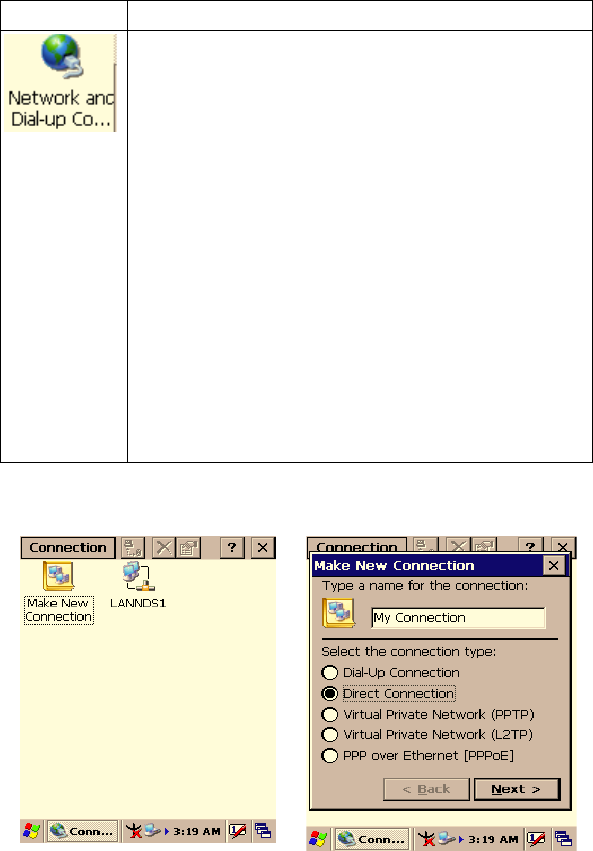
101 Chapter 3
Icon Icon and function
Once you have established an account, create a new
connection on your device. When creating this connec-
tion, you should be able to use all of the default TCP/IP
settings provided in the Make New Connection Wizard. If
you can’t connect using the default settings, contact your
ISP or access your ISP’s Web site for specific TCP/IP
information such as primary and secondary DNS
addresses.
* To modify connection settings:
-Select Start > Settings > Network and Dialup
Connections
- Select the icon for connection settings you want to
modify.
-Select File > Properties, or double- tap the appropri-
ate icon.
- Select desired options. There may be additional set-
tings that depend on the connection. To modify,
select the icon and then select Advanced Set-
tings… from the menu.
Figure 3.60: Network and Dial-up
Connections
Figure 3.61: Network and Dial-up
Connections
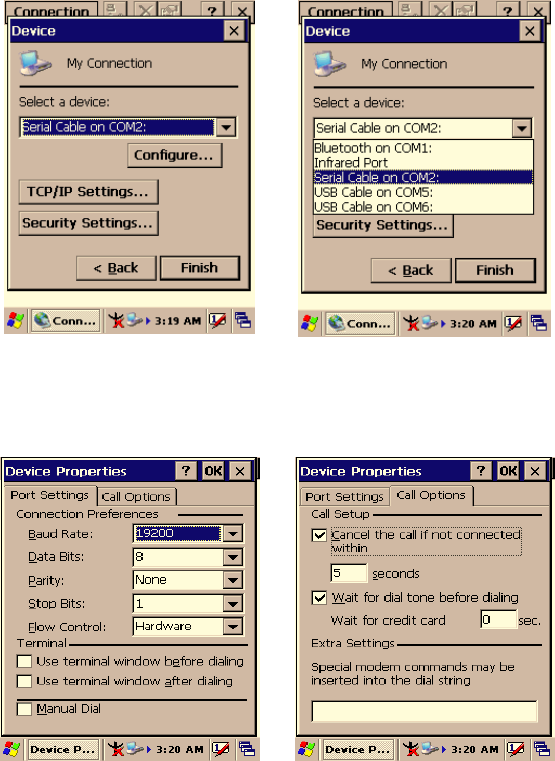
MARS-1030F User Manual 102
Figure 3.62: Network and Dial-up
Connections
Figure 3.63: Network and Dial-up
Connections
Figure 3.64: Network and Dial-up
Connections
Figure 3.65: Network and Dial-up
Connections
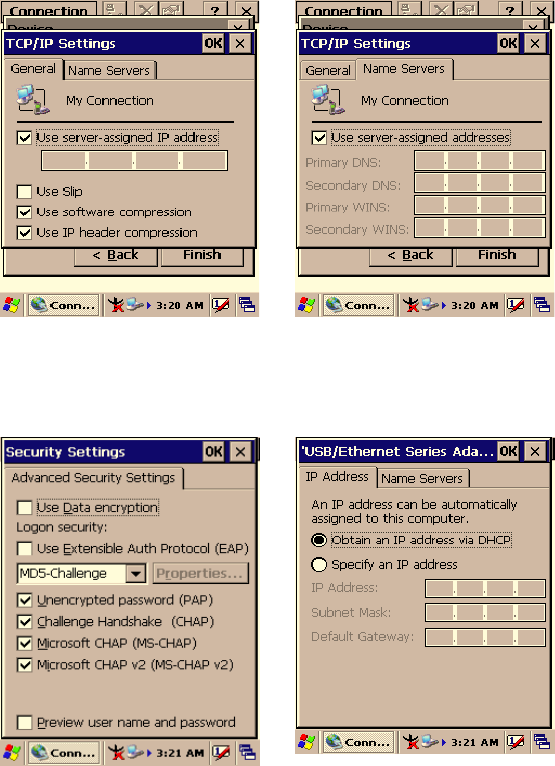
103 Chapter 3
Figure 3.66: Network and Dial-up
Connections
Figure 3.67: Network and Dial-up
Connections
Figure 3.68: Network and Dial-up
Connections
Figure 3.69: Network and Dial-up
Connections
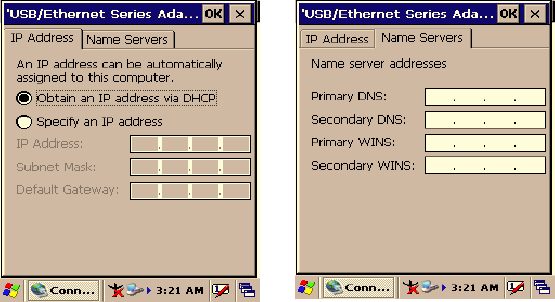
MARS-1030F User Manual 104
Figure 3.70: Network and
Dial-up Connections
Figure 3.71: Network and Dial-up
Connections
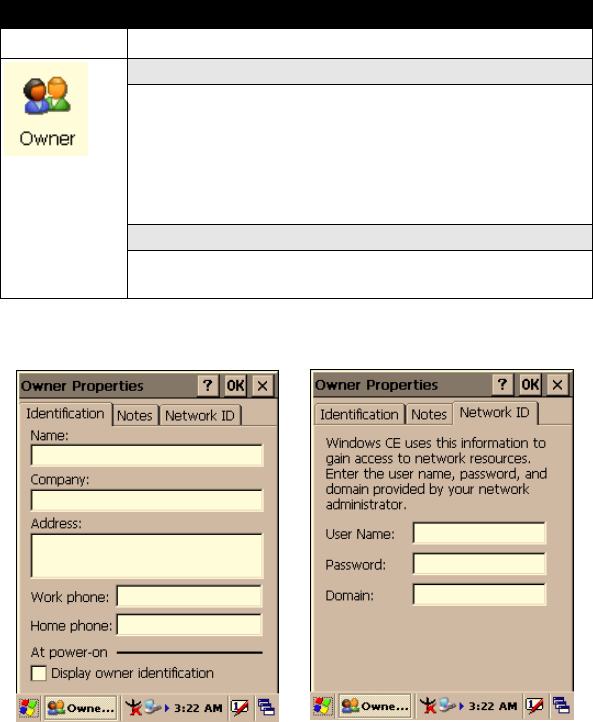
105 Chapter 3
3.2.13 Owner
Table 3.31: Owner
Icon Icon and function
• “Identification” Tab: (Figure 3-74)
* Fill in or edit the data as desired.
* To have this information displayed when you start your
device, select “Display Owner Identification” at
Power On.
* To set up identification for remote networks, see Setting
up identification for remote networks.
• “Network ID” Tab: (Figure 3-75)
* Enter the user name, password, and domain name you
use to log on to remote network.
Figure 3.72: Owner Properties Figure 3.73: Owner Properties
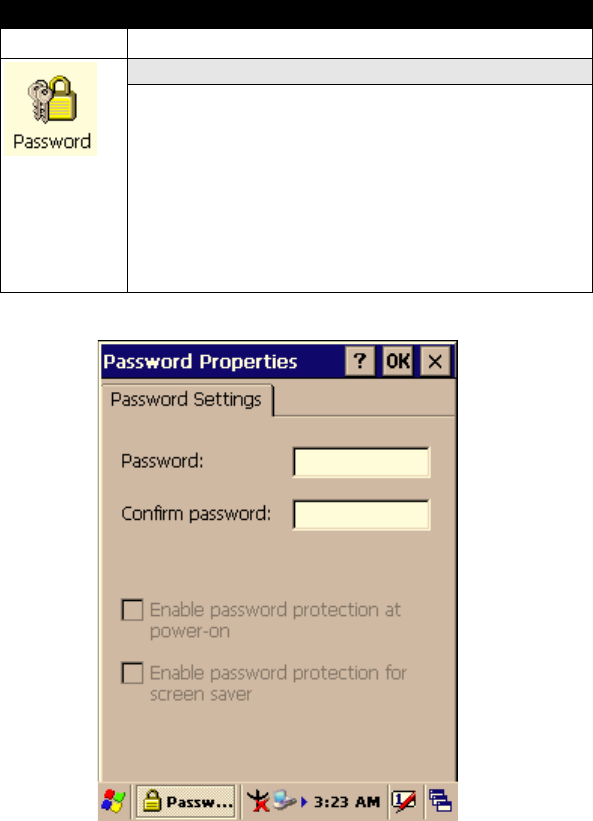
MARS-1030F User Manual 106
3.2.14 Password
Table 3.32: Password
Icon Icon and function
• “Password Setting” Tab: (Figure 3-76)
* Enter the password
* In the “Confirm password“ box, enter the password
again.
* To require the password on startup, select “Enable
password protection at power-on“ and/or select
“Enable password protection for screen saver”.
* To exit the Password control panel, press “OK” from
the control bar, or press the <Enter> key on the key-
pad.
Figure 3.74: Password Properties
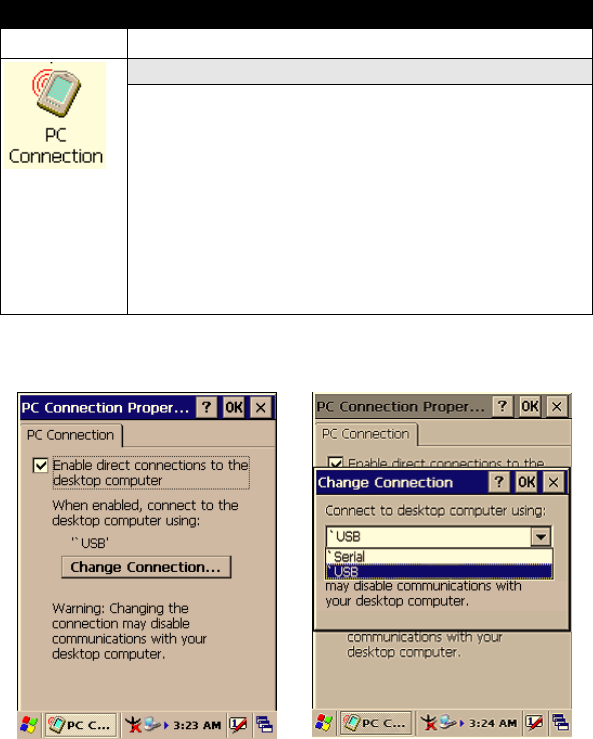
107 Chapter 3
3.2.15 PC Connection
Table 3.33: PC Connection
Icon Icon and function
• “PC Connection” Tab: (Figure 3-77)
* Select the first checkbox to enable direct connections to
the desktop computer. (Figure 3-77)
* Tap the “Change Connection…” button to modify the
connection method to USB or Serial. (Figure 3-78)
* To exit the “Change Connection” dialog, press “OK”
on the control bar, or press the <Enter> key on the key-
pad.
* To exit the “PC Connection” properties control panel,
press “OK” on the control bar, or press the <Enter> key
on the keypad.
Figure 3.75: PC Connection Figure 3.76: PC Connection
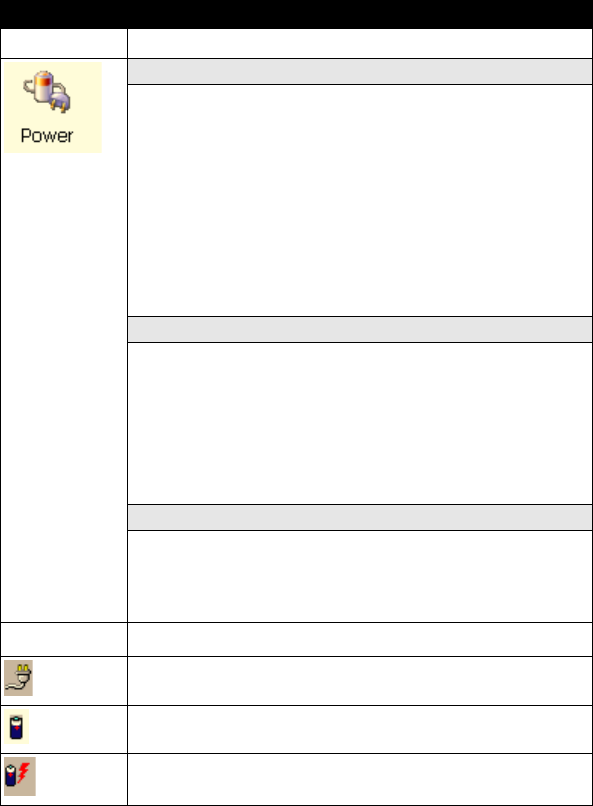
MARS-1030F User Manual 108
3.2.16 Power
Table 3.34: Power
Icon Icon and function
• “Battery” Tab: (Figure 3-79)
* Provide change level indicators for the Main battery
and the Backup battery.
* Show the remaining power capacity of the main battery.
* If a “Main Batteries Very Low” warning message shows,
the MARS-1030F will shut down in 30 minutes. (Figure
3-83)
* The PDT will shutdown when the main battery’s capac-
ity is around 0%.
* To exit the battery control panel, press “OK” from the
command bar, or press <Enter> key on keypad.
• “Schemes” Tab: (Figure 3-80)
* The Scheme tab allows you to determine when to
switch to suspend mode when using either Battery
Power or AC Power.
*Select Battery Power or AC Power as the power
scheme from the pull-down list. (Figure 3-80)
* Select the time to suspend mode from the pull-down
list. (Figure 3-81)
• “Device Status” Tab: (Figure 3-82)
Show the power level of device. The power level ranges
from “High(D0)” which means the device is at the highest
power level to “Off(D4)” which means the device is at the
lowest power level.
Note:
This icon on the taskbar shows that the AC adapter pro-
vides power to the PDT.
The icon on the taskbar shows that Main Batteries pro-
vide power to the PDT.
The icon on the taskbar shows that the AC adapter pro-
vides power to the PDT while charging the main batteries.
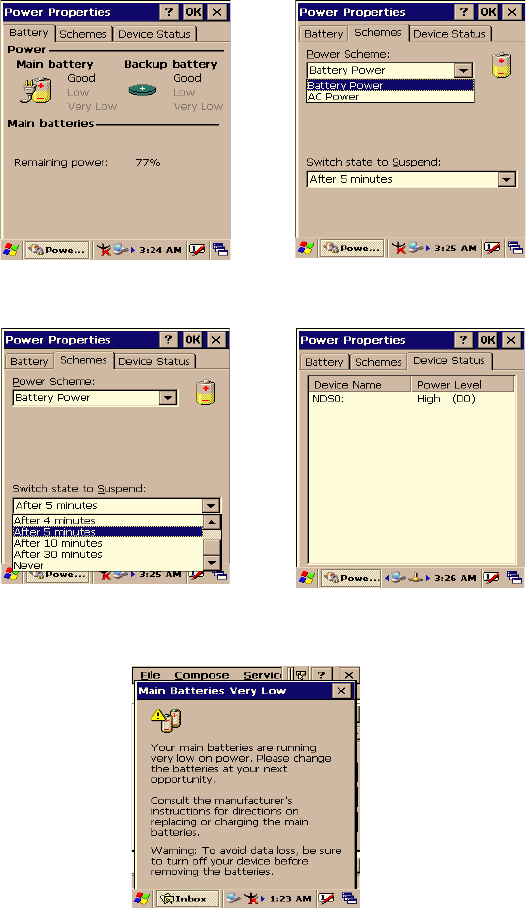
109 Chapter 3
Figure 3.77: Power Figure 3.78: Power
Figure 3.79: Power Figure 3.80: Power
Figure 3.81: Power
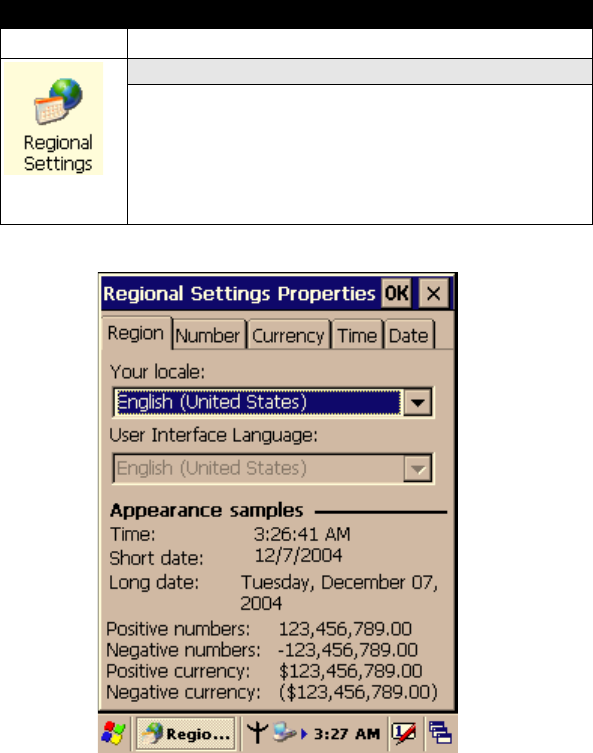
MARS-1030F User Manual 110
3.2.17 Regional Settings
Table 3.35: Regional Settings
Icon Icon and function
• “Region” Tab: (Figure 3-84)
* Select the desired location/language.
* Review the Appearance samples in the bottom half of
the screen.
* Select the tab at the top for any settings you wish to
change. Settings to modify include Number, Currency,
Time, and Date.
Figure 3.82: Regional Settings

111 Chapter 3
3.2.18 Remove Programs
Table 3.36: Remove Programs
Icon Icon and function
• “Remove Programs” Tab:
* Only user installed programs can be removed.
- Select the program you wish to remove from the list
and press the “remove” button.
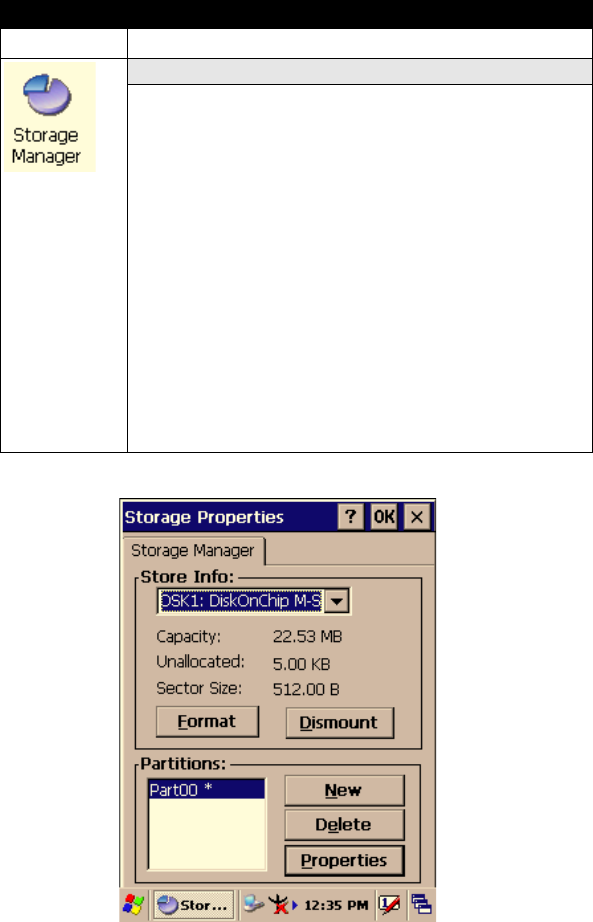
MARS-1030F User Manual 112
3.2.19 Storage Manager
Table 3.37: Storage Manager
Icon Icon and function
• “Storage Manager” Tab: (Figure 3-83)
* To change storage properties control panel default set-
tings:
- Insert a Compact Flash (CF) or Secure digital (SD)
storage card into the unit.
-Select Start > Settings > Control Panel > Storage
Properties
- From the “Storage Info” pull-down list, select the
desired storage device.
- You can also format, dismount, and create parti-
tions on storage devices using this control panel.
- To save and exit the Storage Properties control
panel, press “OK” from the control bar, or press the
<Enter> key on the keypad.
-Caution: Dismounting or formatting the DiskOnChip
will erase all files and programs stored in flash mem-
ory.
Figure 3.83: Storage Manager
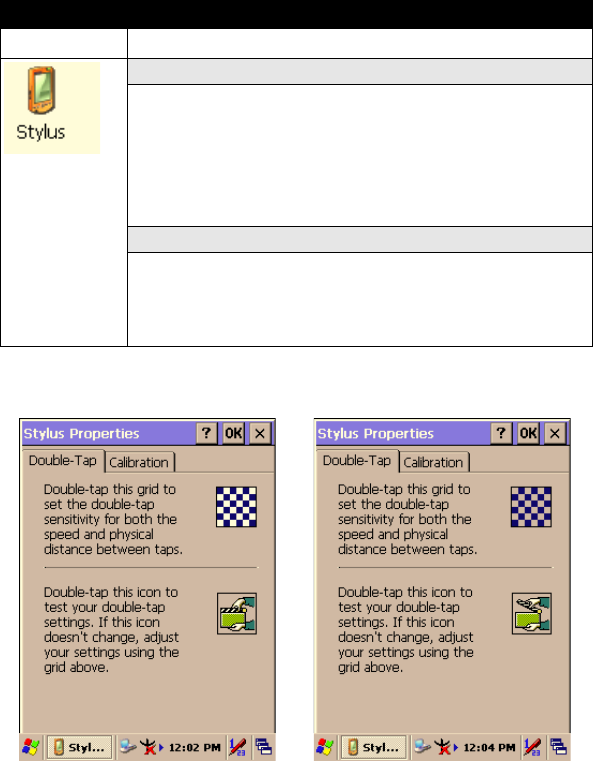
113 Chapter 3
3.2.20 Stylus
Table 3.38: Stylus
Icon Icon and function
• “Double-Tap” Tab: (Figure 3-86, Figure 3-87)
* Double-tap the checkerboard grip at a comfortable
speed.
* Double-tap clapboard to test your settings.
* The function is OK if the figures are changed from Fig-
ure 3-86 to Figure 3-87.
* Tap “OK” to exit the Stylus Properties dialog box.
•“Calibration”: (Figure 3-88, Figure 3-89)
* In the Welcome Wizard, you tapped a target with the
stylus to set the amount of pressure needed for the
screen to respond to your stylus taps.
* Please also see 2.4.3 Calibration of the touch screen
Figure 3.84: Stylus Properties Figure 3.85: Stylus Properties
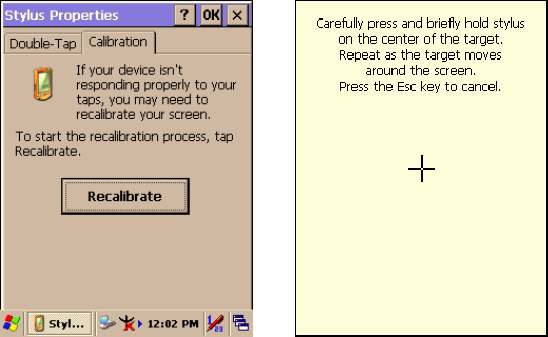
MARS-1030F User Manual 114
Figure 3.86: Stylus Properties Figure 3.87: Stylus Properties
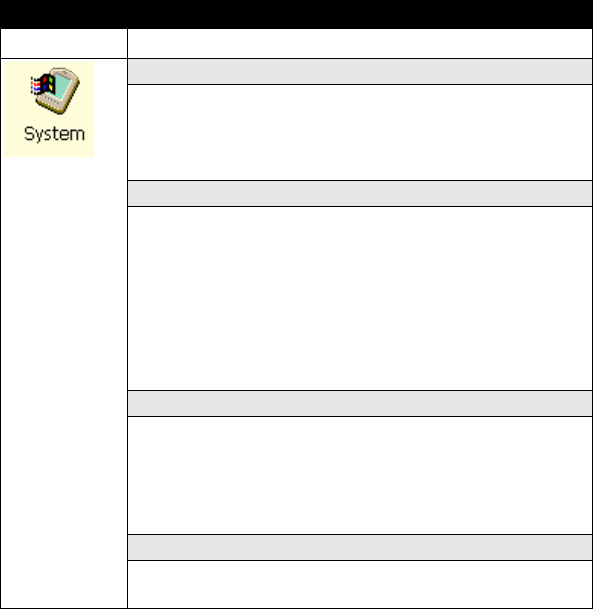
115 Chapter 3
3.2.21 System
Table 3.39: System
Icon Icon and function
• “General” Tab: (Figure 3-90)
* To show:
- Firmware information
- Information about processor type, memory size, and
expansion cards
•“Memory”: (Figure 3-91)
* Move the slider to adjust memory allocation. Default
storage memory is normally is normally set to about 8
MB with the reminder assigned to program memory.
* Press the “OK” key on the Keypad.
Note: The difference between the memory occupied by
the OS and the RAM size is shown in Information proper-
ties, along with the total size of storage memory and pro-
gram memory
• “Device Name” Tab: (Figure 3-92)
* Your device uses this information to identify itself to
other computers.
* The input panel will open to for data entry.
* To close the Device Name, press the “OK” button, or
press the <Enter> key on the keypad.
•“Copyrights” Tab: (Figure3-93)
* Refer to this tab for specific copyright data. As a user,
you are responsible for reading this statement.
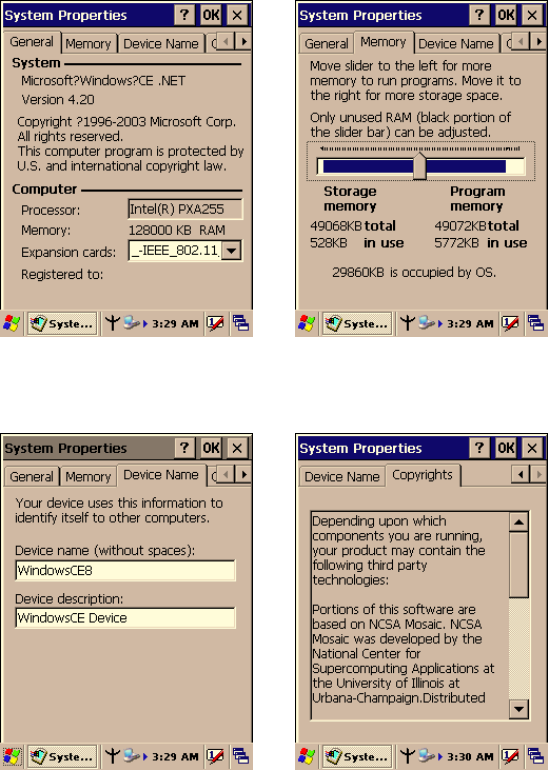
MARS-1030F User Manual 116
Figure 3.88: System Properties Figure 3.89: System Properties
Figure 3.90: System Properties Figure 3.91: System Properties
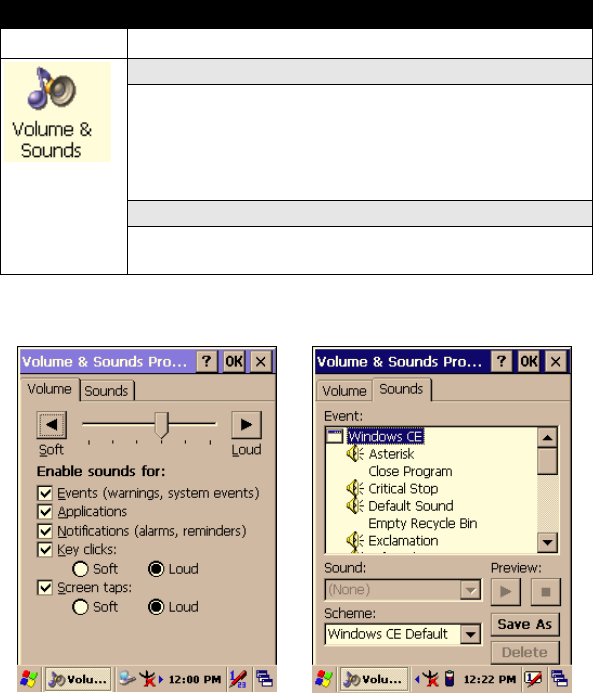
117 Chapter 3
3.2.22 Volume & Sounds Properties
Table 3.40: Volume & Sound
Icon Icon and function
• “Volume” Tab: (Figure 3-94)
* The factory default volume level is the four. You can
adjust the volume to your environment and comfort.
- Set the volume by adjusting the slider from Soft to
Loud, or press the right or left edge of the navigation
keys.
•“Sounds” Tab: (Figure3-95)
* Enable the desired sounds for key clicks, screen taps,
notifications, and applications.
Figure 3.92: Volume & Sound Figure 3.93: Volume & Sound
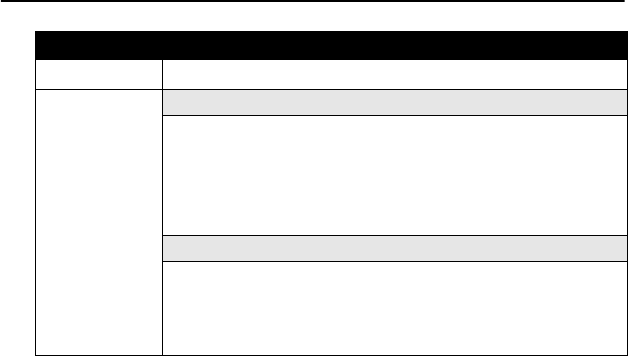
MARS-1030F User Manual 118
3.3 Taskbar and Start Menu
Table 3.41: Taskbar and Start Menu
Icon Icon and function
Taskbar and
Start Menu
• “General” Tab:
* In this tab, You can change the position of the Taskbar
and Start Menu
-Is always on top or not
-Auto hide or not
-Show Clock or not
•“Advanced” Tab:
* Tap the “Clear” button to remove the contents of the
Documents Menu.
* Enable “Expand Control Panel” to list all icons of the
Control Panel from top to bottom.

4
CHAPTER
Communication
This chapter describes how to use the
communication features of the PDT.

MARS-1030F User Manual 120
Chapter 4 Communication
4.1 Installing & Setting Up Microsoft ActiveSync
4.1.1 Installing Microsoft ActiveSync on the Host PC
Microsoft ActiveSync is a file transfer tool to synchronize the files on a
PC with the files on your PDT.
To install Microsoft ActiveSync, complete the following steps on the PC:
1. Go to the Microsoft Windows CE.NET website and download the
latest current version of ActiveSync:
http://www.microsoft.com/mobile/pockeypc/downloads/.
2. Install the latest version of Microsoft ActiveSync on the host PC.
3. Open ActiveSync.
4. Select File > Communication Settings from AtiveSync’s menu
bar.
5. Go to “Using ActiveSync” on page 4-1 to continue using Active-
Sync.
4.1.2 Connecting PDT to Host PC
1. You can use either the USB/Serial (RS232) port of Single Dock or a
USB/Serial (RS232) cable to connect the PDT to the Host PC.
• To use the dock, you must first insert the PDT into the slot, making
sure that the unit is firmly seated the dock.
• To use the cable, connect the USB/Serial cable to the PDT.
2. Connect the USB/Serial dock or cable to the Host PC’s serial port
or USB port.
3. Connect the dock or PDT to the power adapter and power source.
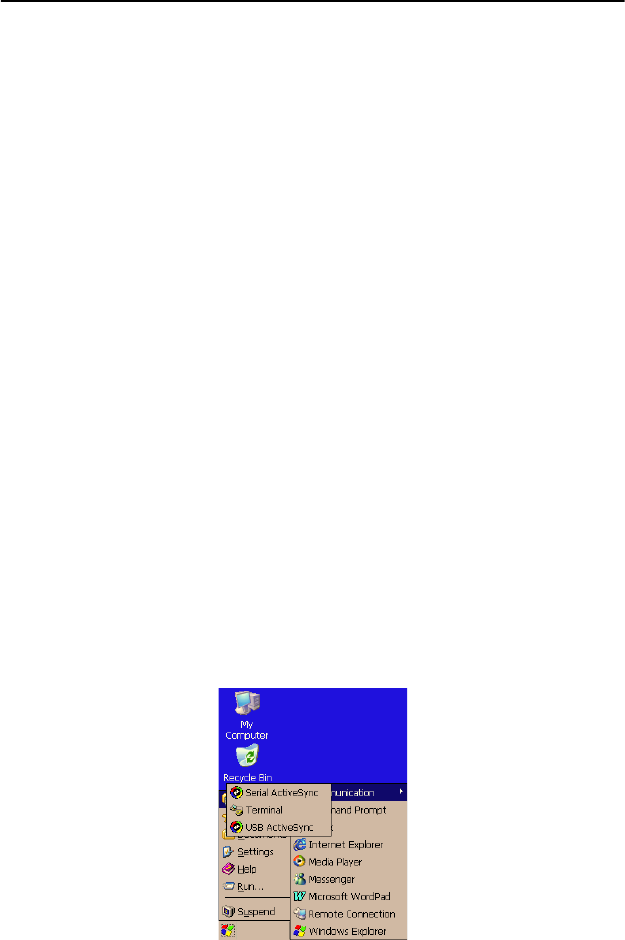
121 Chapter 4
4.2 Using ActiveSync
Use ActiveSync to transfer and synchronize files between the PDT and
the Host PC.
4.2.1 Setting up a Partnership
During the Microsoft ActiveSync installation, you were prompted to
create a partnership with your mobile device. When you set up a
partnership, you select synchronization and file conversation settings,
which are contained in a file on your desktop computer. This file enables
your desktop computer to recognize your device. Only devices that have a
partnership with a desktop computer can synchronize information
between the two computers.
For more information on partnerships, please refer to your Microsoft
ActiveSync documentation or help file.
Transferring Files:
To transfer files, complete the following steps on the host PC:
• Select Start> Programs >Communication > (Serial, or USB)
Activesync.
• Double-click on the selected ActiveSync icon
• After you have established a connection with PDT, tap the
“Explore” button at the top of the ActiveSync window (or select
Explore from the File menu).
• Navigate to the target directory on your PDT and copy the desired
file by using the Copy/paste method or dragging and dropping the
desired file(s) into the folder.
Figure 4.1: Communication
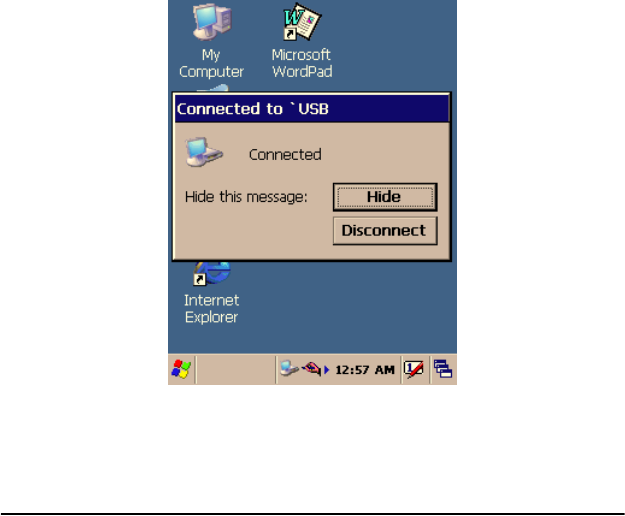
MARS-1030F User Manual 122
4.2.2 ActiveSync File Synchronization
ActiveSync files synchronization requires an ActiveSync partnership
between the PDT and the Host PC. Refer to “Setting up a Partnership”,
above:
• Select the files in the synchronization configuration for the PDT
partnership.
• Select Tools > Options from the ActiveSync command bar to con-
figure the synchronization options.
• Place the file to be synchronized in the Synchronization folder
created you’re My Documents directory. Defaults to the desktop.
During the ActiveSync connection, all files in the Synchronization
folder will be synchronized to the \My Documents directory on the
PDT.
Figure 4.2: Connected
4.3 Networking
Please see the 3.2.14 Owner, Table 3-33 Owner on page 3-45 for setting
up the network ID. And see the 2.5.6 Setting Up Wireless LAN RF to
setup the 802.11b Wireless LAN for RF connecting.

5
CHAPTER
Software Applications
This chapter describes software imple-
mentation procedures.

MARS-1030F User Manual 124
Chapter 5 Software Applications
5.1 Introduction
The PDT includes Calculator and Inbox applications.
You can start any program by tapping the Start Menu.
5.2 Software Applications
5.2.1 Calculator
This can process basic numeric calculations with “+”, “-”, “*” and “/”.
* Procedure:
– Tap a number
– Tap an operator “+”, “-“, “*” or “/”
– Then, tap another number
– Tap another operator or number if needed
–Tap “=” to get the result
* Button Function:
–“MC” – Clear memory
– “MS” – Store the displayed number in the memory
–“MR” – Read the last number that was stored
–“M+” – Add the stored number to the displayed number
–“Backspace” – Same as the “backspace” key
–“CE” – Clear current number. Same as the “Delete” key
–“C” – Clear the current calculation. Same as the “ESC” key
5.2.2 Inbox
Use Inbox to send and receive e-mail messages in the following ways:
* Synchronize e-mail messages with Microsoft Exchange or Outlook
on the Host Computer.
* Send and receive e-mail messages by connecting directly to an e-
mail server through an Internet server provider (ISP) or a network.
To setup “Inbox”:
* Select Start> Programs> Inbox.
125 Chapter 5
* Select Service> Options from the command bar. Drag the dialog to
show the right edge so that you can configure e-mail.
* Select “Add…” (Note 1)
* In the “Service Type” list, select POP3 Mail or IMAP4 Mail.
(POP3 is the most common mail protocol for ISPs). Enter a unique
name for the e-mail service in the “Service name” field. This name
cannot be changed later.
* Select “OK”.
* The Mail Service Setup wizard appears after you add a service. If
you are adjusting the settings of an existing service, select Service>
Options, select the service you want to modify, and then select-
Properties. In the Service Definition dialog box, complete the fol-
lowing entries as needed:
–Connection: Select the name of the connection you created to
connect to the mail server. If you are receiving e-mail through a
network (Ethernet) connection, select Network Connection. If
you want Inbox to use your current connection, select (none). If
you have not created a connection, select Create new connec-
tion. Double-tap the “Make new Connection” icon, and follow
the instructions in the wizard. When finished, select Inbox on
the Taskbar and continue setting up the Inbox.
–POP3 Host (POP3 only): Enter the name of the mail server you
use to receive and send messages.
–Server (IMPA4 only): Enter the name of the mail server you
use to receive and send messages.
–User ID: Enter the user name or mailbox ID assigned to you.
–Password: Enter the password you use to access this mail
account. If you do not want to be prompted to enter the pass-
word each time you connect, select “Save password”.
–Domain (Windows NT): Enter your Windows NT domain
name. This name is required only when connecting to networks,
such as a corporate network, that use Windows NT domain
security. This is not required for most ISP accounts. If you have
trouble connecting, try clearing this box.
–SMTP Host: If your mail service uses a separate server for
SMTP, enter the name in the box. If you’re setting up a POP3
Mail service with an ISP, the ISP must use an SMTP mail gate-
way.
–Return Address: By default, the return address is set to
username@POP3host or username@Servername. This
MARS-1030F User Manual 126
depends on the service you are using. If this is not your e-mail
address, enter the correct address in the box.
*Set general preferences:
If you are adjusting the setting of an existing service, select Ser-
vice> Options, select the service you are using, select Properties,
and then select Next. In the General Preferences dialog box,
choose any of the following settings, all of which are optional:
–Disconnect service after actions are performed: Select to
automatically disconnect from the server upon completion of all
pending actions. This option minimizes connection time and
cost.
–Check for new messages every: Select how often (in minutes)
you want the device to check for new mail. If this option is
turned off, you must check for new mail manually by selecting
Services> Send/Receive Mail.
–Display a message box when new mail arrives (POP3 only):
Select this to be informed that new mail has arrived.
–Display a message box when new mail arrives (IMAP4 only):
Select this to be informed that new mail has arrived.
–Send using MIME format (POP3 only): Select this to send
messages with extended characters.
–Only display messages from last 3 days: Select how many
messages per day you want downloaded.
*Set inbox preferences
If you are adjusting the settings of an existing service, select Ser-
vices> Options, select the service you are using, select Properties,
and then select New twice. In the Inbox Preferences dialog box,
choose any of the following options:
–Get message headers only: Select to save storage space and
time by downloading only headers. You can download a full
copy of the message later by selecting the message and then
Services> Get Full Copy.
–Include <number> lines: Select to set the message length
(approximate number of lines) that you want to download.
–Get Full Copy of messages: Select to receive a full copy of all
messages. In addition to the message body, any options you
select in When getting full copy will be downloaded. Selecting
this option increases the amount of time needed to download
messages.
127 Chapter 5
–Only synchronize folder hierarchy under Inbox (IMAP4
only): Select to reduce download time by preventing the com-
plete downloaded of the folder list every time you connect.
–Get meeting requests (POP3 only): Select to download and
store copies of meeting requests when getting full copies of
messages. This setting applies whether you have chosen to
download full copies of messages by default, or you selectively
download full copies of messages by opening the message and
selecting Services> Get Full Copy Limitations apply.
–Get file attachments (POP3 only): Select to download and
save message attachments when getting full copies of messages.
This option may use significant RAM and network bandwidth.
This setting applies whether you download full copies of mes-
sages by default, or selectively download full copies of mes-
sages by selecting Services> Get Full Copy.
–Get file attachments and meeting requests (IMAP4 only):
Select to download and store meeting requests and message
attachments when getting full copies of messages. This setting
applies whether you download full copies of messages by
default, or selectively download full copies of messages by
selecting Services> Get Full Copy. Limitations apply.
–Only if small than (IMAP4 only): Select this to restrict the size
of the attachments you download. Set this to 10 KB if you want
to receive meeting requests only.
*Include the original message in a reply:
– Select Services> Options> Compose tab.
– Under Reply, select Include Body. This setting will place a
copy of the original message beneath your response text.
– To indent the original message, select Indent.
– To add leading characters (such as>) to the original message
lines, select Add leading character, and enter the character
you want.
*Save copies of sent messages:
By default, sent messages are not saved on your device. To enable
messages to be saved automatically:
– Select Services> Options> Compose tab.
– Select Keep copy of sent mail in Sent folder.
*Set the action to follow deleting, moving, or responding to a
message:

MARS-1030F User Manual 128
– Select the Services> Options> Read tab.
– Select the desired options.
*Delete a message:
Select the message and then select File> Delete. Messages are
moved to the Deleted (local) folder and deleted according to the
option you have selected in the Services> Options> Delete tab:
–On connect/disconnect: Deletes messages when you connect
or disconnect from your mail service or exit the Inbox.
–Immediately: Deletes messages as soon as you select File>
Delete.
–Manual: Deletes messages when you select File> Empty
Deleted (local)
Note: If you are working offline, messages are deleted from the device
the next time you connect.
*Empty the Deleted (local) folder:
–Select File> Empty Deleted (local) to permanently delete mes-
sages in the Deleted (local) folder.
– To check or adjust the current settings for deleting messages,
select the Services> Options> Delete tab.
*Move or copy a message:
– Select the message
– Select File> Move To or File> Copy To.
– Select the destination folder. If you are working offline, the
message will be moved or copied from the server the next time
you connect.
*Folder-
•Create a folder:
– Select File> Folder> New Folder
– Type a name for the folder.
Caution: When you move a message that you have received
through POP3 or synchronization to a folder you created on your
device, the copy of the message on the server is deleted. This pre-
vents duplicate copies of messages. Although the complete message
is moved, message attachments will be deleted if you have not
selected the option to download attachments. Once the message is
moved, you will be able to access the message only from your
device.
129 Chapter 5
•Delete a folder:
– Select the folder you want to delete
– Select File> Delete
•Designate a folder as offline:
Only IMAP4 folders can be designated as offline. All IMAP4
default folders, such as Inbox, are automatically designated as
offline. Messages in offline folders can be viewed when you are
disconnected from your mail server. If a folder is not designated as
offline, you will be able to read and respond to messages in that
folder only when connected to the server.
– To designate a folder as offline, select the folder and then select
Service > Offline Folder.
•Rename a folder:
– Select the folder you want to rename.
– Select File> Folder> Rename Folder.
– Type the new name for the folder.
Notes:
• Default folders, such as Inbox, can’t be renamed.
• Folders you create for IMAP4 mail servers can’t be renamed.
•Synchronize folders while connected:
When you synchronize folders, the contents of your device folders
and mail server folders are compared and updated. New mail mes-
sages are downloaded, and messages in your device Outbox folder
are sent. The synchronization behavior depends on how you con-
nect to your mail server.
– When you connect to a POP3 server, the Inbox and Outbox
folders on your device are synchronized with the corresponding
folders on the mail server. To synchronize after the initial con-
nection, select Services> Send/Receive Mail.
– When you connect to an IMAP4 server, all folders, including
the Inbox and Outbox, that are marked as offline are synchro-
nized. To synchronize all folders after the initial connection,
select Services> Synchronize Folders. To synchronize just the
selected folder and the Outbox folder, select Services> Send/
Receive Mail.
*Compose and send a message:
– In list view, select Compose> New Message
– Enter the address of one or more recipients, separating them
with a semicolon. If the recipient is listed in the Address Book,
MARS-1030F User Manual 130
enter a few letters of the recipient’s name and select Compose>
Check Name. If there is only one match, the e-mail address is
inserted. If there is more than one match, select the correct
address from the Choose E-mail Recipients dialog box. If
there is no match then add a new e-mail address through
Choose E-mail Recipients.
– To attach a file, select File> attachments> Add Attachment.
– Select File> Send. If you are working offline, the message is
moved to the Outbox folder and will be sent the next time you
connect.
Tip: To see more header information, select the triangle in the lower-right
corner of the header area. Select the triangle again to collapse the header
area.
*Save a message:
– Select File> Save to save the message you are composing or
editing.
The message is not sent and is saved in the inbox folder of the
active service.
*Reply to or forward a message:
– Open the message, and then select Compose> Reply to Sender,
Reply to All, or Forward.
– Enter your response.
– Select File> Send.
Tips:
• Selections in the Options dialog box determine whether the original
text is included.
• To see more header information, select the inverted triangle in the
lower-right corner of the header area. Select the triangle again to
collapse the header area.
*Check Inbox status:
– In list view, select Compose> Status. You can view details such
as the number of messages to be sent, deleted, and copied, and
the number of attachments to be downloaded.
*Download message from the server:
– When you download messages, you need to create two connec-
tions: a remote connection and a mail server connection. The
remote connection connects you and your ISP or network. The
131 Chapter 5
mail server connection enables messages to be downloaded
from your mail server to the Inbox on your device. When you
select Services> Connect to Inbox, the Inbox starts a remote
connection using the connection you specified when setting up
the current mail service. If you are already connected through a
remote connection other than the one you specified in the ser-
vice, you will be asked if you want to use the current connec-
tion. If you choose not to, you will need to disconnect from the
current connection before you can check for new messages.
– Select the Services menu and make sure that the service you
want to use is selected (the selected service has a bullet next to
it).
– Select Services> Connect. The messages on your device and
mail server are synchronized: new messages are downloaded to
the device Inbox folder, messages in the device Outbox folder
are sent, and messages that have been deleted on the server are
removed from the device Inbox. Double-tap a message list to
open it.
– If you read a message and decide that you need a full copy,
select File> Get Full Copy while in the message window or
Services> Get Full Copy while in list view. This will also
download message attachments and meeting requests if you
have those options selected in the Inbox Preferences dialog
box. You can also choose to download full copies of messages
by default.
– When finished, select Services> Connect to disconnect. You
also need to disconnect your dial-up connection by double-tap-
ping the icon in the status bar and selecting Disconnect.
Notes:
• Receiving entire messages consumes memory.
• The size column in the Inbox list view displays the local size and
server size of a message. Even when a message has been down-
loaded fully, these numbers may differ because the size of a mes-
sage can very between the server and the device.
• When using IMAP4 to get Outlook data, you will see the contents
of your Journal folder. File editing transactions and documents
(such as Task items, e-mail message, and Word documents)
attached using drag and drop will appear as shortcuts on the device.
A copy of the document will not be moved to your device, and the
shortcut on the device cannot be used. To access the documents
MARS-1030F User Manual 132
associated with a journal entry on the device, attach the document
to the entry rather than dragging and dropping it. Also, be sure to
set your IMAP4 service to receive full copies of messages, attach-
ments, and meeting requests. For more information on using the
Journal, see the Help for the desktop version of Outlook.
* Working with Message Attachments:
– If you receive messages through a remote mail server, in Inbox
on the device, select the Get file attachments and meeting
requests (IMAP4) or Get meeting requests (POP3) setting in
the Inbox Preferences dialog box. For more information, see
Set Inbox preferences.
Notes:
• Embedded images and OLE objects cannot be received as attach-
ments.
• Embedded messages can be viewed as an attachment when using
IMAP4 to receive e-mail. However, this features does not work if
TNEF is enabled so that you can receive meeting requests.
* Check attachments status:
– An attachment sent with an e-mail message, whether it has been
downloaded or not, will appear as an icon at the bottom of the
message in its own window. If you don’t see this pane, select
File> Attachments> Show Attachments. If TNEF is turned on
so you can receive meeting requests, you will not see attach-
ments until they are fully downloaded.
– To mark an attachment for downloading in a POP3 or IMAP4
service, double-click it. The attachment will be downloaded the
next time you connect. You can also set Inbox to download
attachments automatically when you get a full copy of a mes-
sage. For more information, see Receive attachments.
*Open an attachment:
– With the message open, double-tap the attachment’s icon at the
bottom of the message. If you don’t see this pane, select File>
Attachments> Show Attachments.
*Store an attachment:
– Select Service> Options> Storage tab.
– Select to store attachments in internal RAM or on a storage
card.
– If you use more than one storage card, select it from the list.
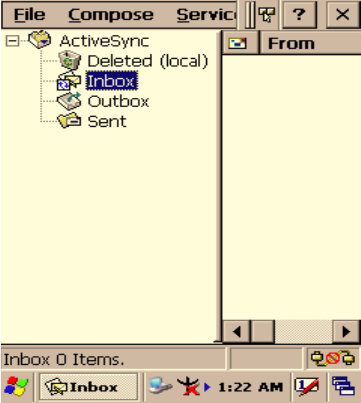
133 Chapter 5
Note: Once you make the above selection, all attachments will be moved
to the selected card.
* Delete an attachment:
– To delete an attachment from a message you are sending, select
the attachment, and then select Edit> Clear or press the DEL
key on the keypad.
– To delete an attachment you have received, delete the message.
*Attach a file to a message:
– With the message open, select File> Attachments> Add
Attachment.
– Select the file you want to attach.
Note:
OLE objects cannot be attached to Inbox messages.
Note 1: To add a mail service, select “Add”, To remove a mail service,
select the service from the Installed service box and select “Remove”.
To view a mail service’s properties, select the service from the Installed
service box and then select Properties.
Figure 5.1: Inbox
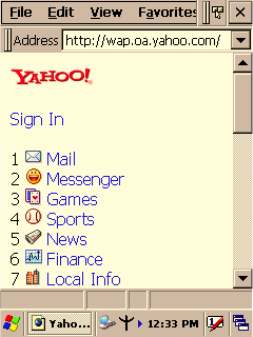
MARS-1030F User Manual 134
5.2.3 Internet Explorer
With the Internet Explorer, it is possible to view the Web or intranet Web
pages. A modem or WLAN is required to connect to an Internet server
provider (ISP) or network.
5.2.3.1 Connect to the Internet
5.2.3.3 Navigation control
Internet Explorer uses sliding menus for navigation control. Tap and drag
the sliding menus to the left or right to reveal hidden menu items and
toolbars.
To view a larger screen space in the Internet Explorer, hide the Status bar
and the View menu. From the top menu bar, select View > Hide Tool-
bars.
Once hidden, it is necessary to “cold reset” these features to access them
again. (Refer to “2.7.2 Cold Reset” for more information.)
To view Web pages, set up a remote
connection to your ISP or network.
5.2.3.2 Start Internet Explorer
* Open Internet Explorer by
selecting Start > Programs >
Internet Explorer.
* To setup the default home page,
navigate to the web page that is
desired for use as the default web
page.
* Select View > Internet Options
from the command bar.
* Enter the desired URL in the
Start page field.
* Press the OK button.
Figure 5.2: Internet Explorer
135 Chapter 5
5.2.3.4 Set up a proxy server
Proxy servers are often used when connecting to the Internet through a
local network for added security.
* Select View > Internet Options > Connection Tab.
* Select Access the Internet using a proxy server.
* Enter the proxy server address and port. For more information, see
your administrator.
* To bypass the proxy server of a local address, such as corporate
intranet pages, select Bypass proxy for local address.
5.2.3.5 Enable cookies
A cookie file contains information about identity and preferences so that
a website can tailor information. The website automatically sends the file
to the receiving device.
* Select View > Internet Options > Security Tab.
* Select Allow cookies.
5.2.3.6 Search for an internet site
* Select View > Go > Search to search the web.
5.2.3.7 Go to an internet address
* Select Address Bar, if necessary to display the Address bar
* Enter the address.
* Press “ENTER” key.
5.2.3.8 View previously visited sites
* Tap the Arrow button at the right site of the Address Bar.
* Select the desired Web Address to view.
5.2.3.9 Add and view favorites
* Go to the desired page.
* Select Favorites > Add To Favorites.
* If necessary, locate the appropriate folder.
* Confirm or change the name and save the site address.
MARS-1030F User Manual 136
* To view favorite Web sites, select Favorites and highlight the Web
page to view. IE automatically navigates to the website.
Note:
To organize the favorites list, select Favorites > Organize Favorites.
5.2.3.10 Browse Web pages
* To view a page previously visited, select View > Back.
* To move forward again to the next page (provided it was viewed
previously,) select View > Forward.
* To return to the Home page, select View > Go > Home.
5.2.3.11 Refresh current page
* Select View > Refresh.
5.2.3.12 Stop loading a page
* Select View > Stop.
5.2.3.13 View current page
* Select View > Internet Options.
* To view the protocol, page type, size, and address, select the Gen-
eral tab.
* To view the security information about the page, select the Secu-
rity tab.
5.2.3.14 View HTML source code
* While viewing the page, select File > Save As and save the file as a
.txt file.
* Open the file in a word processing program, such as WordPad.
5.2.3.15 Change home and search page settings
* Select and open the page to use as the home or search page.
* Select View > Go > Home or Search.
137 Chapter 5
5.2.3.16 Save a copy of current page
It is possible to save web pages and view them later when disconnected
from the Internet or Intranet, without using cached memory.
* Select File > Save As
* Specify a folder location and give the file a name.
5.2.3.17 Copy a web page to a document
* Select all or part of the web page to be copied.
* Select Edit > Copy.
* Go to the text or html document to place the information, and select
the location in the text.
* Select Edit > Paste.
5.2.3.18 Select security options
* Select View > Internet Options > Security tab.
* Select the necessary security protocols.
5.2.3.19 Change the font size
* Select View > Text Size and select the desired size.
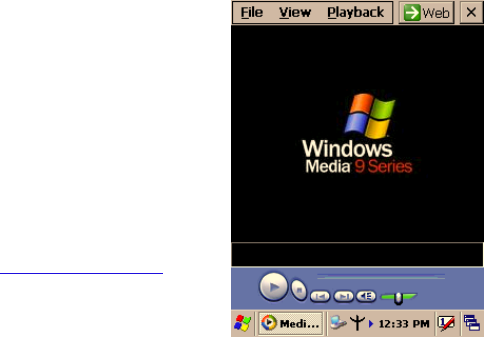
MARS-1030F User Manual 138
5.2.4 Media Player
5.2.5 Messenger
* The Windows CE Messenger client application in Windows
CE.NET allows real-time communication using text-based messag-
ing, VOIP, and more.
* See who’s online, and when colleagues are online. Notify a pre-
defined list of watchers about any pertinent information.
* Talk with a colleague anywhere in the world using a microphone
and speakers. Windows Messenger supports high-quality voice
calling on a Windows CE device.
* Communicate using Session Initiation Protocol (SIP) or Hotmail
contacts Windows Messenger supports. Communication with col-
leagues using a SIP based communications service. Talk to Hotmail
contacts using .NET Messenger.
The PDT comes with Media
Player for Windows CE.NET
installed.
* Open Media Player by
selecting Start > Pro-
grams > Media Player
from the desktop.
* Select File > Open to
open a new media file.
* Please refer to
www.microsoft.com for
additional information
and help with your
Microsoft Windows
Media Player.
Figure 5.3: Media Player

139 Chapter 5
5.2.6 Microsoft WordPad
Create and edit documents and templates in WordPad, using buttons and
menu commands that are similar to those in the desktop version of
Microsoft Word. It is possible to work with files in Normal or Outline
views.
WordPad documents are usually saved as .pwd files, but it is possible to
save documents in other file formats, like .rtf or .doc.
5.2.6.1 Selecting and editing text
* Select text
*Find text
– To search for text in one part of a document, select that part.
Otherwise, the whole document is searched.
– Select Edit > Find
– Enter the text you want to find. For a paragraph, enter ^p. For a
tab stop, enter ^t.
– Select the search options you want.
– To continue searching, select Edit > Find > Next.
*Replace text
– To replace text in one part of a document, select that part. Oth-
erwise, the whole document is searched.
– Select Edit > Replace.
– Enter the text to replace and the text to substitute. For a para-
graph, enter ^p. For a tab stop, enter ^t.
– Select the replacement options.
– Select Find Next.
–On the Find/Replace toolbar, select the appropriate button.
To select Do this
Any amount of text Drag the stylus over the text.
A word Double-tap the word.
A single paragraph Triple-tap within the paragraph.
An entire document Select Edit > Select All
An picture Tap the picture
MARS-1030F User Manual 140
*Move, copy, or delete text
– Select the text you want to move, copy, or delete.
– To move or delete text, select the Cut button. To copy text,
select the Copy button.
– To paste the information, move the insertion point to the desired
location, then press the cursor over a Paste button.
Notes:
• To undo an action, select Edit > Undo.
• To restore the action, select Edit > Redo.
5.2.6.2 Formatting text
* Creating bulleted and numbered lists.
– Select the Bullets or Numbering button.
– Type the first item.
– Press ENTER, type the next item, and repeat as needed.
– Select the button again to end list formatting.
Note: To change the number style for the selected list, select Format >
Paragraph, In the Format list, select the style you want.
*Set the default font
– Select Format > Font.
– Select the font from the list of available fonts.
– Select Set As Default
– To confirm that changes will be applied to subsequent docu-
ments, select Ye s .
Note: To apply the default font and stylus to selected text, select Apply
Default.
*Select a different font
– Select the text you want to change. To select all text, select Edit
> Select All.
– From the Font list, select the desired font.
– From the Font Size list, select a size.
Note: To see more formatting options, select Format > Font.
141 Chapter 5
*Change font formatting
– Select desired text.
– Select the Bold, Italic, or Underline button.
– To change the font color, select Format > Font and select the
color from the Color list.
*Adjust the paragraph alignment
– Select the paragraph to align using the mouse and cursor.
– Select the Align Left, Center, or Align Right button.
Note: To see more formatting options, select Format > Paragraph.
* Indent a paragraph
– Select the paragraph to indent.
– Select Format > paragraph.
– Adjust the indentation settings as needed.
*Set tabs
– Select Format > Tabs.
– Change the tab settings as needed.
5.2.6.3 Adjusting the Display
* Wrap text in the window
– Select View > Wrap to Window.
*Display the document in full screen view
– Select View > Full Screen.
– To exit Full Screen view, select Restore.
– To move the Restore button, drag the bar on the left side.
* Display or hide scroll bars
– Select View > Horizontal Scroll Bar or Vertical Scroll Bar.
* Zoom in or out
– Select View > Zoom, and select the desired percentage.
Note: For Custom, enter the exact percentage and select OK.
MARS-1030F User Manual 142
5.2.6.4 Working in outline view
* Switch between Normal and Outline views
– Select View > Normal or Outline.
* Assign and change outline levels
– Select View > Outline.
– Select the appropriate buttons on the toolbar.
5.2.6.5 Inserting symbols
* Place the insertion point where you want to insert the symbol.
* Select Tools > Insert Symbols.
* Select the symbol you want, and then select Insert.
Tips:
If selecting a different font (or subset of a font), a different set of symbols
will be displayed.
5.2.6.6 Printing a document
* Select File > Print.
* Select the desired printing options.
Tips:
•Port lists the available printer ports.
•If Network is selected from the Port list, enter the path to the net-
work printer to the Net Path box.
5.2.6.7 Setting a password for a document
* Select File > password.
* Type and verify the password.
* Saving the document is necessary (File > Save) to return the pass-
word.
143 Chapter 5
5.2.6.8 Converting Documents
*About document conversion
If an e-mail program is installed and receives an attached Word
document or template created in Word version 6.0 or later, Word-
Pad can convert the file. To view the document, simply open the
attachment in WordPad.
During conversion, some formatting attributes may be changed or
lost. To avoid losing these attributes permanently, close the file
after viewing it, rather saving the file on the device. If saving the
file, save it with a different file name.
For more information about performing conversions on your
device, study the following topics:
* Changes caused by Word document conversion
• Formatting
–Borders and Shading
Borders and shading are not displayed in WordPad, but are
restored if converted back to a Word document. Shading is not
restored when used in a table, but simple borders are restored.
–Character formatting
Bold, italic, strikethrough, superscript, subscript, and hidden
text are retained and displayed. Other effects are changed or
removed.
–Colors
Colors are retained and mapped to the colors available on the
current system.
–Fonts and font sizes
Fonts not supported by your mobile device are mapped to the
closest font available in WordPad.
–Page Formatting
Headers, footers, footnotes, columns, pages setup information,
and style sheets are removed during conversion to WordPad.
WordPad supports built-in headings.
–Paragraph formatting
Tabs, alignment, bullets, indentation, simple numbered lists,
and paragraph spacing are retailed and displayed in WordPad.
MARS-1030F User Manual 144
•Pictures
Pictures are removed during conversion.
•Table of Contents
Table of Contents text and some formatting are preserved. How-
ever, any text set at right-aligned tab stops may wrap to the next
line.
•Index
Index text and some formatting are preserved.
•Tables
Tables appear as tab-delimited text. Cells containing wrapped text,
tabs, or paragraph markers may be difficult to read. Simple tables
are displayed accurately and restored when converting a WordPad
file back to a WordPad document.
•OLE Objects
OLE Objects are removed during conversion.
•Revisions marks, annotations, and comments
Revision marks are visible but cannot be changed. Annotations
and documents are removed during conversion.
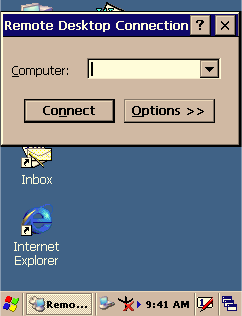
145 Chapter 5
5.2.7 Remote connection
The Remote Desktop Connection can log onto the Windows Terminal
Server and then access and use all the programs installed on the server.
For example, instead of running Microsoft Pocket Word, you can run the
desktop version of Microsoft Word.
5.2.7.1 Connecting to terminal server
5.2.7.2 Disconnecting without ending a session
* In the Remote Connection window, select Start > Shutdown.
* Select Disconnect > OK.
Note: If previously disconnected from a Terminal Server without ending
the session, the Terminal Server will continue to execute any run-
ning processes; the Remote Connection can later reconnect to this
same session (provided that the administrator has configured
Remote Connection to reconnect later to disconnected sessions).
5.2.7.3 Disconnecting and ending a session
*In the Remote Connection window, select Start > Shutdown.
* Select Log Off > OK.
* Select Start > Programs
> Remote Connection, or
run ‘CETSC’ from the
command prompt.
* In the Server box, type or
select a Terminal Server, a
name or TCP/IP address,
or select a server in the
drop-down list.
* Select Connect.
*In the Remote Connec-
tion window, type your
user name, password, and
domain, (if required), and
then select OK.Figure 5.4: Remote Connected
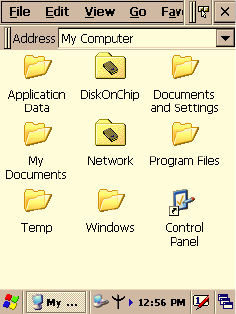
MARS-1030F User Manual 146
5.2.8 Windows Explorer
5.2.8.1 Navigating in file view
*Go forwards and back
– To go back to the previous folder, select Go > Back.
– To go forward again to the folder previously viewed, after hav-
ing gone back, select Go > Forward.
*Use the Go menu
– To quickly access the My Documents folder, select Go > My
Documents
– To see all folders that have been accessed, select Go > History.
Double-tap a folder to return to it.
5.2.8.2 Viewing files as icons lists
* To view icons, select View > Large Icons or Small Icons.
* To view a list, select View > Details.
5.2.8.3 Working with files and folders
*Create a new folder
– If necessary, open the folder in which the new folder is to be
placed.
Windows Explorer works almost the
same on a PDT as it does on the PC. See
the topics below for information about
the difference between Windows
Explorer on each device.
Figure 5.5: Windows Explorer
147 Chapter 5
– Select File > New Folder.
*Add a folder to your Favorites list
– Open the folder
– Select Favorites > Add to Favorites.
–In the Name box, type the shortcut name.
Tips:
• To open a favorite file or folder, select Favorites and then select
the folder.
• To organize your favorites, select Favorites > Organize Favorites.
*Transfer a file using infrared
– To send a file, select it, line up the infrared ports, and select File
> Send To > Infrared Recipient.
– To receive a file, line up the infrared ports, and select File >
Receive.
5.2.8.4 Creating desktop shortcuts
* Display the file or web page for which a shortcut is needed.
* Select File > Send to.
* Select Desktop as Shortcut.
5.2.8.5 Switch to internet
* Type a URL in the address bar.
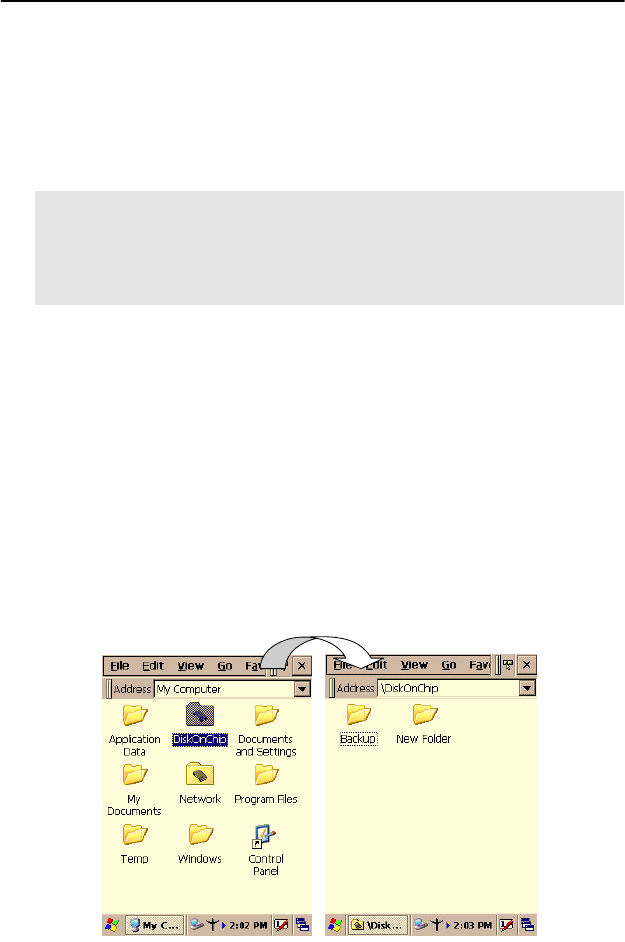
MARS-1030F User Manual 148
5.3 DiskOnChip
The DiskOnChip helps to save applications or data files onto a Flash
Memory device.
Note: The DiskOnChip storage memory resists all reset (warm/cold
reboot) conditions and software/firmware updates.
It is strongly recommended to install all applications, applets, programs
and important data files onto a DiskOnChip Flash.
5.3.1 Saving to flash
To save an application or data to the Flash Memory, from the current
application, select File > Save As > navigate to the DiskOnChip location
and save it.
5.3.2 DiskOnChip location
To access the contents of files in the DiskOnChip storage:
* Double-tap the My Computer icon on the desltop.
* Double-tap the DiskOnChip icon to view DiskOnChip.
Figure 5.6: DiskOnChip
Caution:
If an application or a data file is only installed or saved in the RAM,
a hard reset will result in the loss of that application or data file.
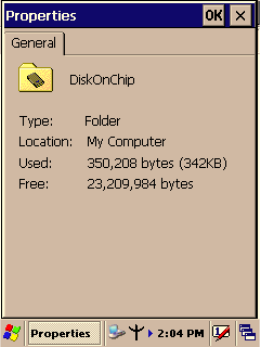
149 Chapter 5
5.3.3 DiskOnChip size
The size of the DiskOnChip will vary,
depending on the size of system
firmware.
* Inside the DiskOnChip
directory, tap File > Properties.
* The DiskOnChip Properties
dialog:
The number listed after Free is the
amount of memory bytes currently
available on the device for the Dis-
kOnChip system.
Figure 5.7: DiskOnChip Size

A
APPENDIX
Barcode Setting
This appendix provides instructions
for customizing the barcode engine.
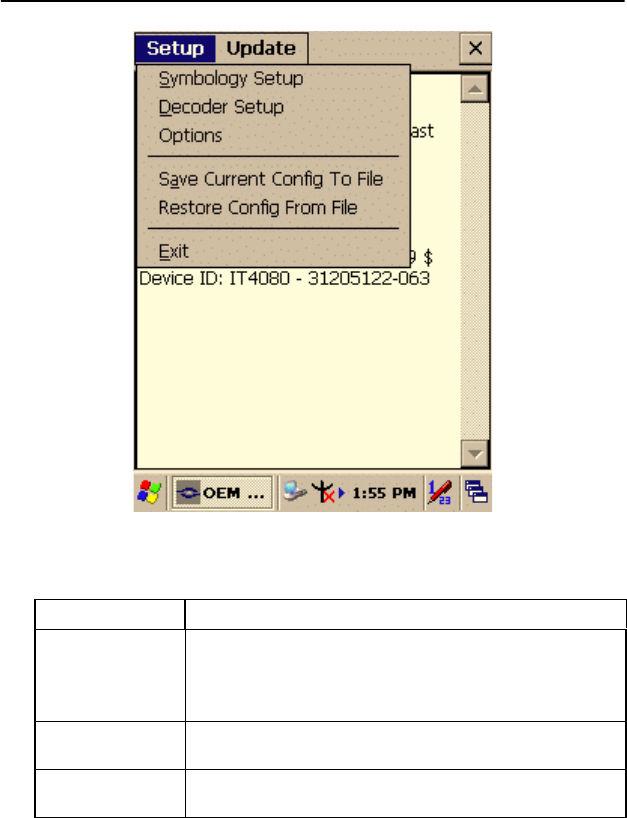
MARS-1030F User Manual 152
Appendix A Barcode Setting
A.1 Setup Tab
Functions:
Item Explanation
Symbology
Setup
Selecting the Symbology Setup menu item causes the
symbology setup dialog to be displayed. This dialog
consists of a symbology drop down list, plus four but-
tons and a message box.
Decoder Setup Selecting the decode menu item displays the decode
options dialog box.
Options Selecting the Options Menu item displays the Setup
dialog box

153 Appendix A
Item Explanation
Save Current
Config to File
The application has the capacity to save the Config
file. The Config file that is saved when this item is
selected is correlated to the Config that is currently
active. A dialog is presented and requests selection of
a name for the file to save. The default file extension
matches the current active Config. Saving a Config file
this way is independent from the Config Format option
of the Imager menu. In this case, the Config file is
saved as it appears on the screen instead of how it
was received.
Restore Config
From File
This selection restores the Config from any file. The
restored Config file is full size, uncompressed, and
unprocessed.
Exit Selecting Exit shuts down the Application Program.
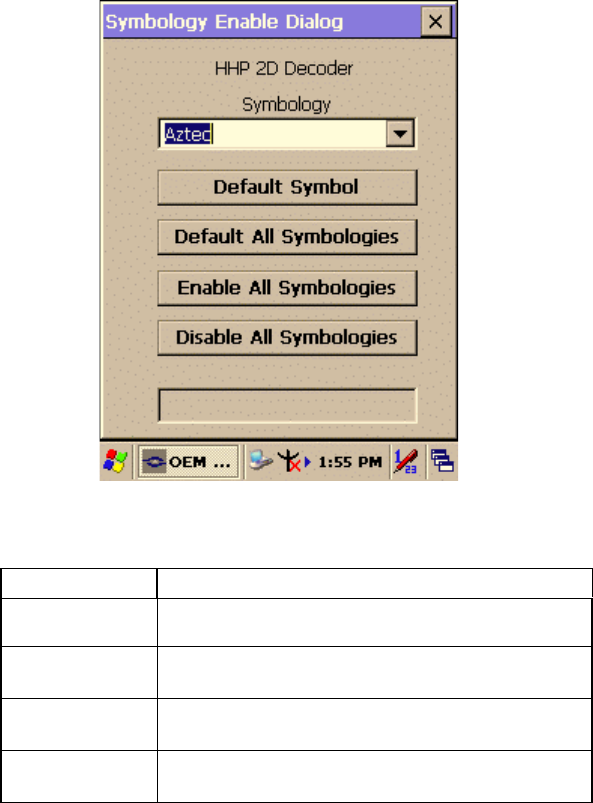
MARS-1030F User Manual 154
A.1.1 Symbology setup
Selecting the Symbology Setup menu item display the symbology setup
dialog. This dialog consists of a symbology drop down list, plus four but-
tons and a message box.
Functions:
Item Explanation
Default Symbol Defaults the current symbology shown in the drop
down list to the internal default.
Default All
Symbologies
Defaults all symbology options for all symbologies to
the internal defaults.
Enable All
Symbologies
Enables all symbologies, but does not change other
symbol options.
Disable All
Symbologies
Disables all symbologies without affecting other
symbol options.
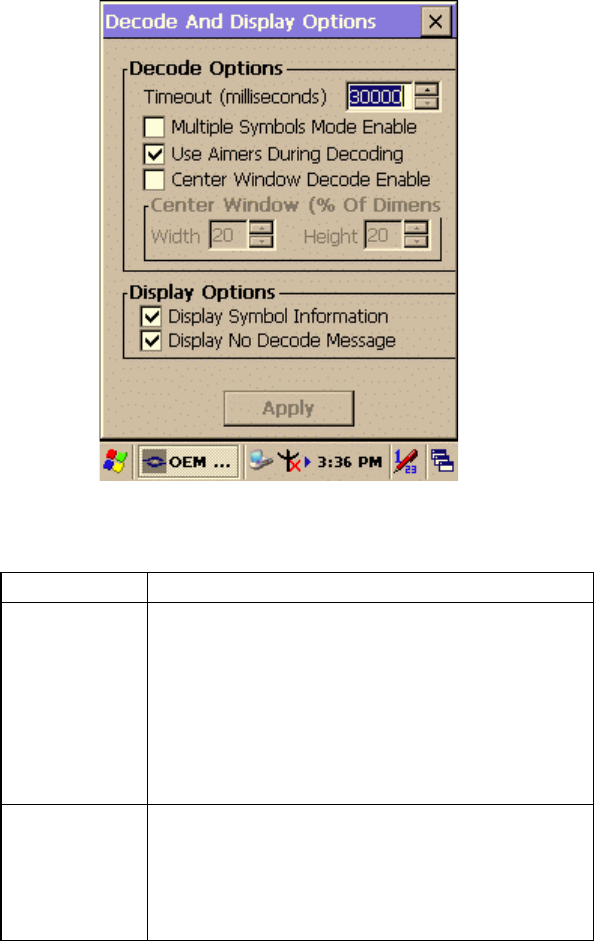
155 Appendix A
A.1.2 Decoder setup
Functions:
Item Explanation
No Read
Timeout
Maximum time (in milliseconds) that the imager
attempts to decode before declaring a “No Decode”
condition. If attempting to decode using the trigger key,
the imager quits decode attempts even if the trigger key
remains depressed. A new decode using the trigger
can only begin after the trigger is released. The timeout
also applies to the decode operation of the imaging
technology. The Timeout range is 0, meaning no time-
out, (i.e., infinite) to 300,000.
Multiple
Symbols Mode
Enables/Disables multiple symbols decoding. Normally
the imager stops attempting to decode when a bar
code symbol is decoded. In multiple symbols mode, the
imager does not stop until the trigger is released or a
“No Decode” timeout occurs. The same bar code will
not be read again until the current decoding stops.

MARS-1030F User Manual 156
Item Explanation
Aimers During
Capture Enables/Disables aimers during decoding.
Center Window
Decode Enable
A decoded symbol is returned only if it intersects a
rectangle specified by the center window.
Center Window
Center Window indicates the percent-age of width and
height of the center decode rectangle, relative to the
entire image. The limits are 0-100%. The default is
20x20 (128x96 pixels).
Display Symbol
Information
The Display Symbol Information option enables /
disables display of decoded symbol information, which
includes the AIM ID, SymID (Code ID), and symbol
modifier.
Display No
Decode
Message
Enables / disables display “No Decode” message if no
bar code symbol is decoded by either a timeout or trig-
ger release.
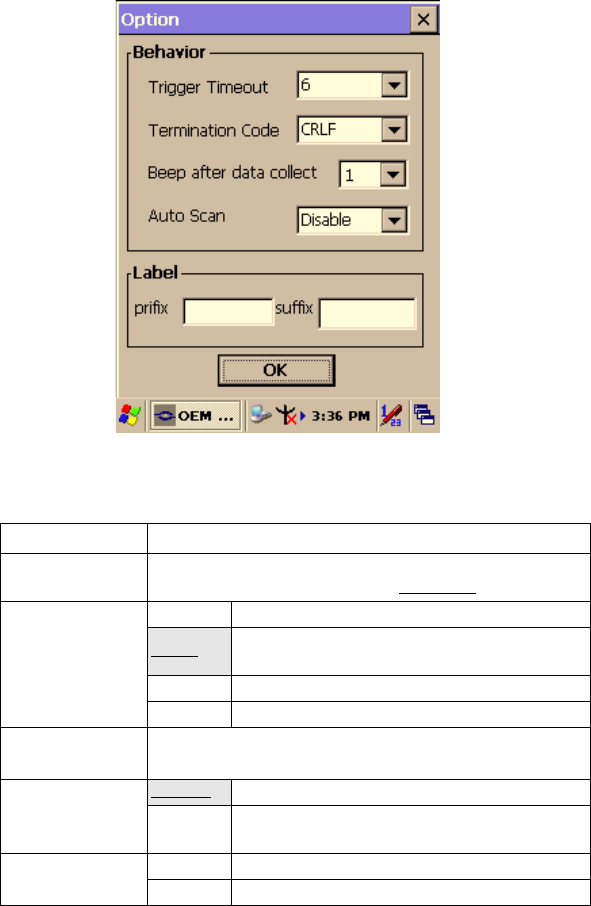
157 Appendix A
A.1.3 Options
Functions:
Item Explanation
Trigger Timeout Select the scanning timeout duration (in seconds) from
the pull-down list. <3 ~ 10 sec, Default: 6>
Termination
Code
None After showing barcode, no action.
CRLF After showing the barcode, jump to next
row.
Space After showing the barcode, jump one unit.
Tab After showing the barcode, jump a section.
Beep after data
collect Select a beep tone after data is collected.
Auto Scan
Disable Disable this function.
1 ~ 5 sec Alternate number of seconds for Continuous
Scan.
Label Prefix Type the desired label prefix in this text box.
Suffix Type the desired label suffix in this text box.
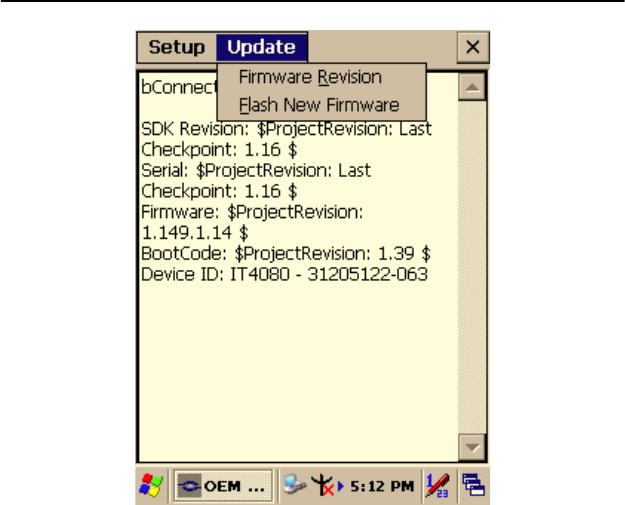
MARS-1030F User Manual 158
A.2 Update Tab
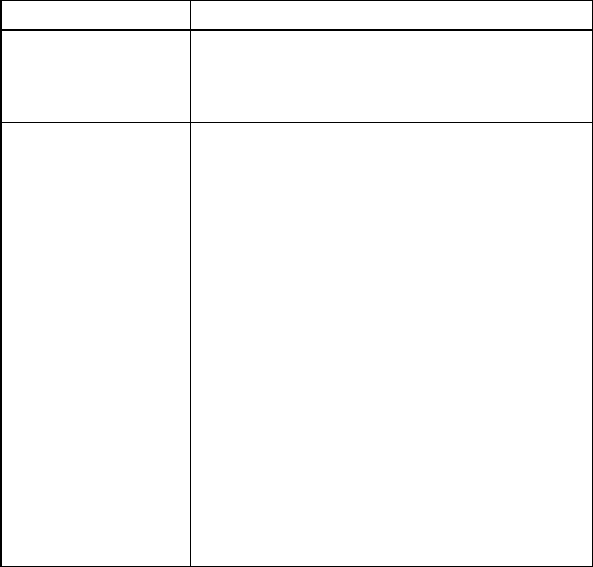
159 Appendix A
Functions:
Item Explanation
Firmware Revision
When this item is selected, the imager is queried
for the current firmware version information. The
version information is then displayed in the text
window.
Flash New Firmware
This item allows new engine firmware to be
installed into the imager. When Flash New
Firmware is selected, a prompt to select the firm-
ware file appears. The file, which must have the
extension “.bin”, must reside on the PDT. The
firmware file can be copied to the PDT using
Microsoft Explorer as long as the PDT is linked to
the PC via Microsoft's Active Sync. The default
search location is the My Documents folder. Once
a file is selected, the file is transferred to the
engine. The engine then writes the new firmware
into flash memory and re-initializes. The flashing
of the firmware and subsequent restart takes
approximately 30 seconds. The application
insures that the unit does not enter suspend
mode during that time.
Note: It is very important that the device remains
awake during this time. Failure to do so can
cause the scan engine to become unusable.
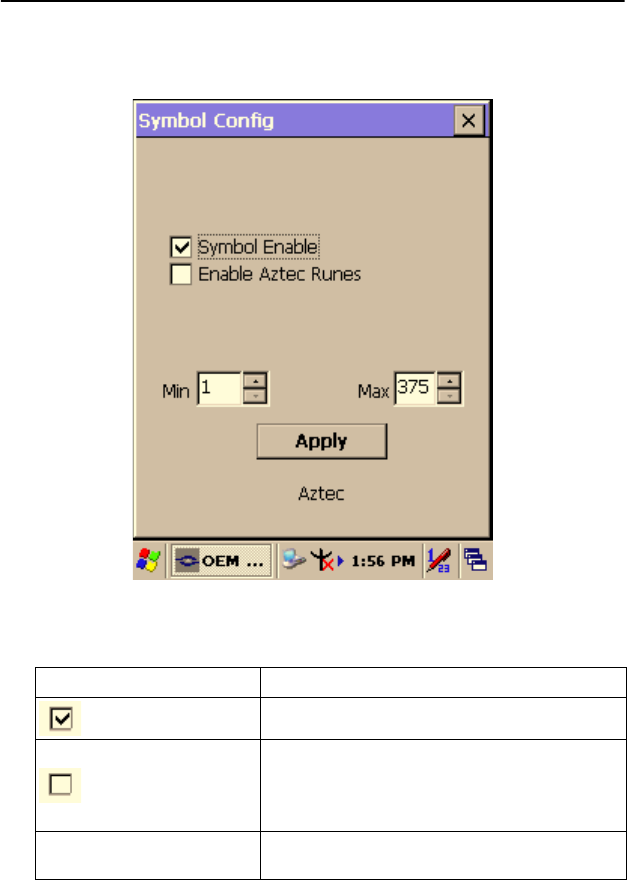
MARS-1030F User Manual 160
A.3 Symbologies List
A.3.1 Aztec
Functions:
Item Explanation
Symbol Enable Enable this barcode.
Enable Aztec Runes
Enable if you are scanning Aztec Runes, the
smallest type of Aztec Code symbols, which
have the capacity to encode a very short
license plate message.
Message Length The minimum and maximum length ranges
for the barcodes are 1 - 3750.
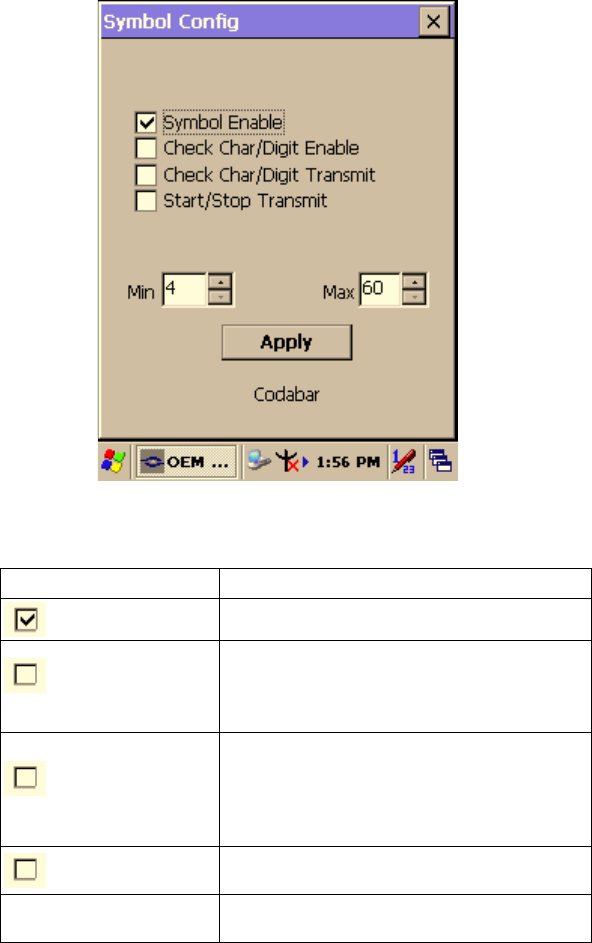
161 Appendix A
A.3.2 Codabar
Functions:
Item Explanation
Symbol Enable Enable this barcode.
Check Char/Digit
Enable
The scanner can read barcode data with a
check digit. If this item is not checked, the bar
code is read as though no check digit was
present.
Check Char/Digit
Transmit
The scanner will only read Codabar bar codes
printed with a check digit, and will transmit
this character at the end of the scanned data.
This setting is only valid if check char/digit is
enabled.
Start/Stop Transmit Start/Stop characters identify the leading and
trailing ends of the barcode.
Message Length The minimum and maximum length ranges
for the barcode are 2 - 60.
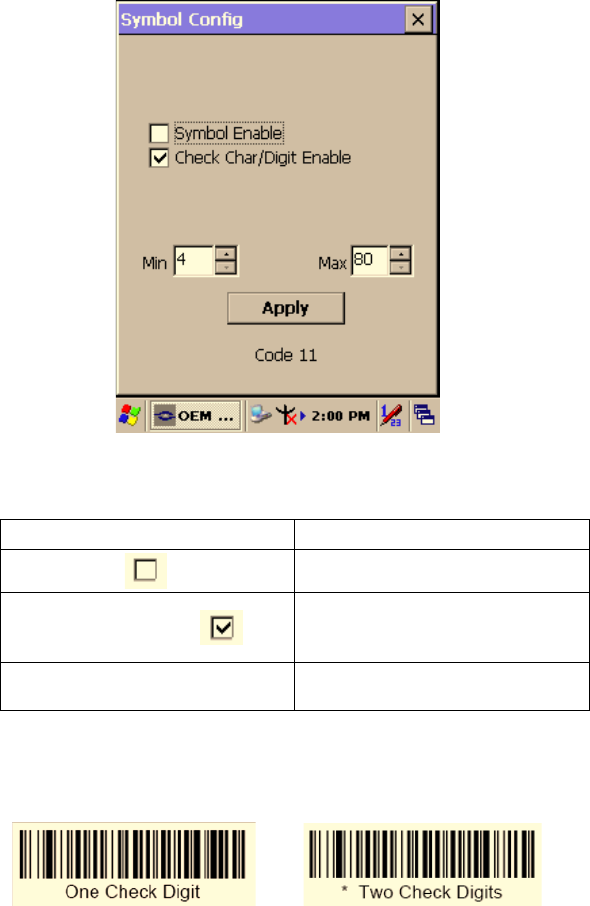
MARS-1030F User Manual 162
A.3.3 Code 11
Functions:
Check Digits Required
Default = Two Check Digits.
Item Explanation
Symbol Enable Enable this barcode.
Check Char/Digit Enable
This option sets whether 1 or 2
check digits are required with Code
11 type barcode.
Message Length The minimum and maximum length
ranges for the barcode are 1 - 80.
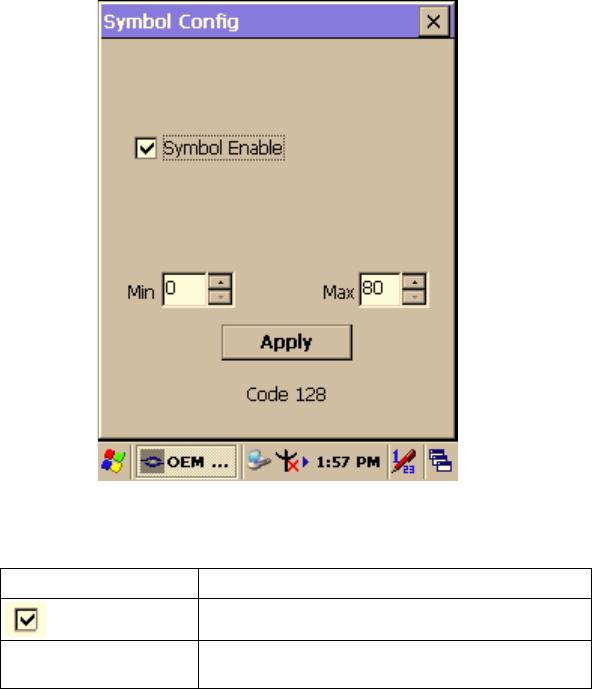
163 Appendix A
A.3.4 Code 128
Functions:
Item Explanation
Symbol Enable Enable this barcode.
Message Length The minimum and maximum length ranges for
the barcode are 0 - 80.
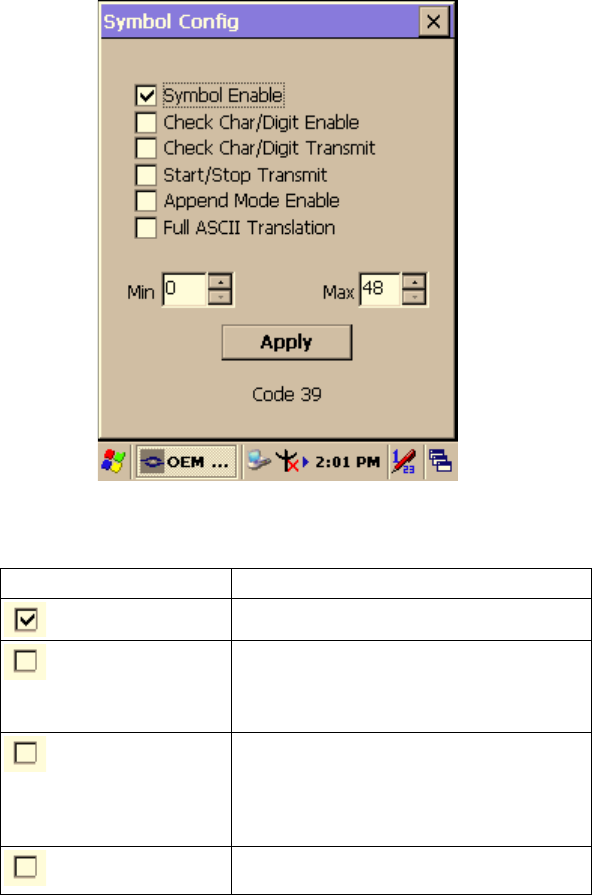
MARS-1030F User Manual 164
A.3.5 Code 39
Functions:
Item Explanation
Symbol Enable Enable this barcode.
Check Char/Digit
Enable
The scanner reads barcode data with a
check digit. If not checked, the barcode will
be read as though no check digit was
present.
Check Char/Digit
Transmit
The scanner will only read Code 39 type
barcodes printed with a check digit, and will
transmit this character at the end of the
scanned data. This setting is only valid if
check char/digit is enabled.
Start/Stop Transmit Start/Stop characters identify the leading
and trailing ends of the barcode.
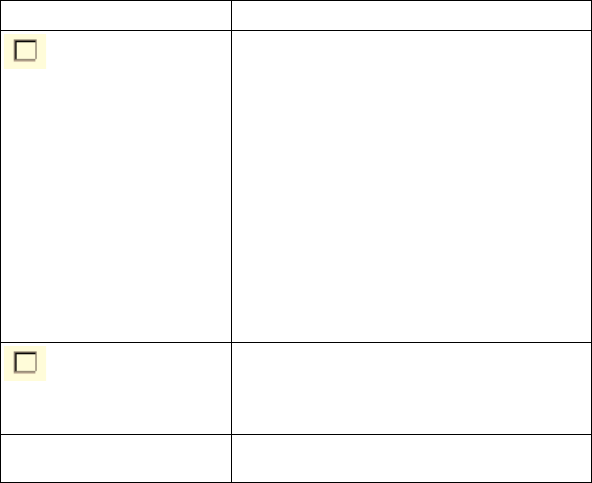
165 Appendix A
Item Explanation
Append Mode Enable If this box is checked, the scanner can
append the data from several Code 39
barcodes together before transmitting them
to the host computer. When this function is
enabled, the scanner stores those Code 39
barcodes that start with a space (excluding
the start and stop symbols), and doesn’t
immediately transmit the data. The scanner
stores the data in the order in which the bar-
code are read, deleting the first space from
each. The scanner transmits the appended
data when it reads a Code 39 bar code that
starts with a character other than a space, or
when it reads a barcode that is not Code 39.
Full ASCII Translation If Full ASCII Code 39 decoding is turned on,
certain character pairs within the barcode
symbol will be interpreted as a single char-
acter.
Message Length The minimum and maximum length ranges
for the barcode are 0 - 48.
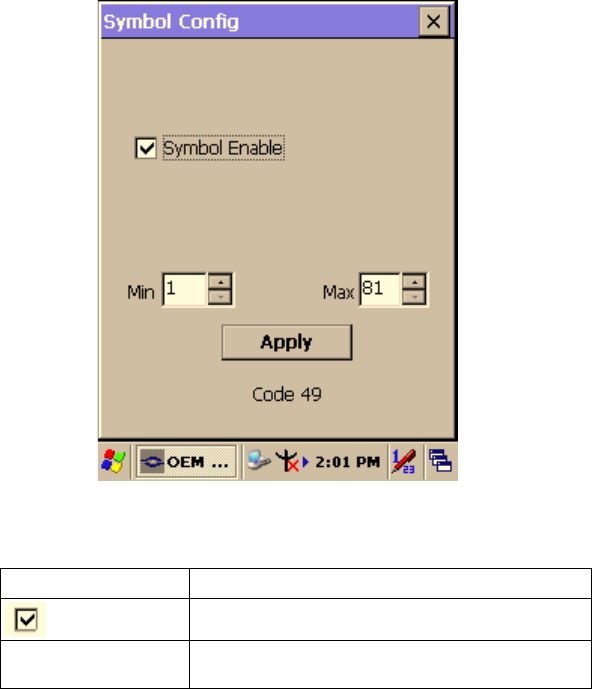
MARS-1030F User Manual 166
A.3.6 Code 49
Functions:
Item Explanation
Symbol Enable Enable this barcode.
Message Length The minimum and maximum length ranges for the
barcode are 1 - 81.
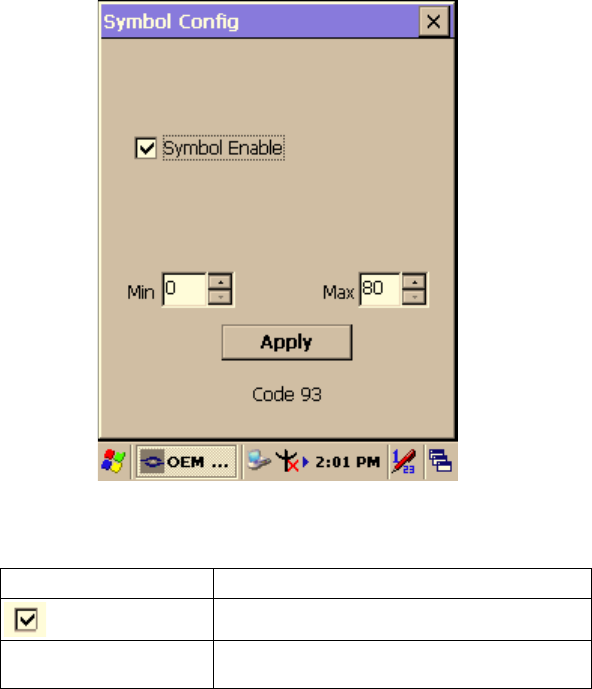
167 Appendix A
A.3.7 Code 93
Functions:
Item Explanation
Symbol Enable Enable this barcode.
Message Length The minimum and maximum length ranges for
the barcode are 0 - 80.
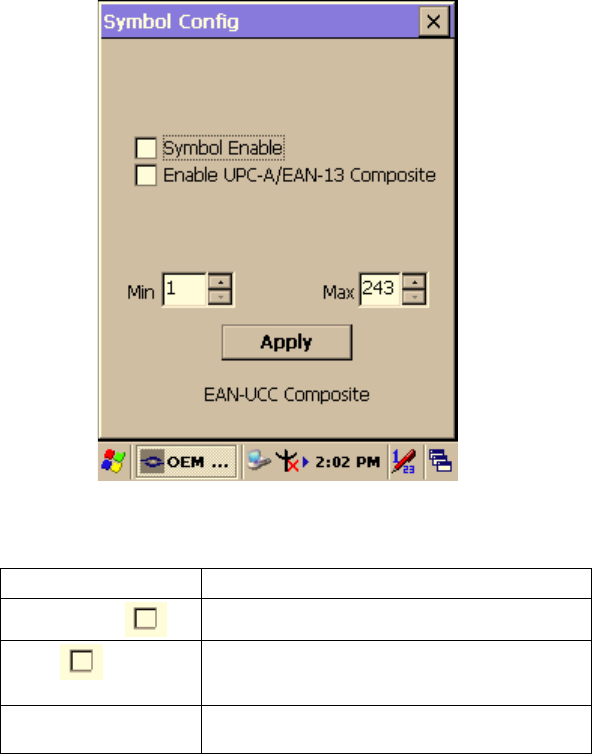
MARS-1030F User Manual 168
A.3.8 Composite Codes
Functions:
Item Explanation
Symbol Enable Enable this barcode.
Enable UPC-A/
EAN-13 Composite
Enable to scan UPC-A/EAN-13 Composite
codes.
Message Length The minimum and maximum length ranges for
the barcode are 1 - 2435.
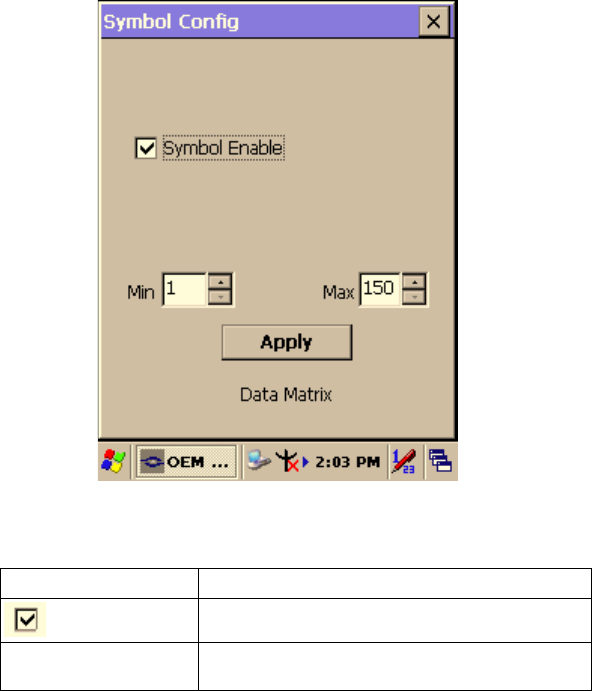
169 Appendix A
A.3.9 Data Matrix
Functions:
Item Explanation
Symbol Enable Enable this barcode.
Message Length The minimum and maximum length ranges for
the barcode are 1 - 1500.
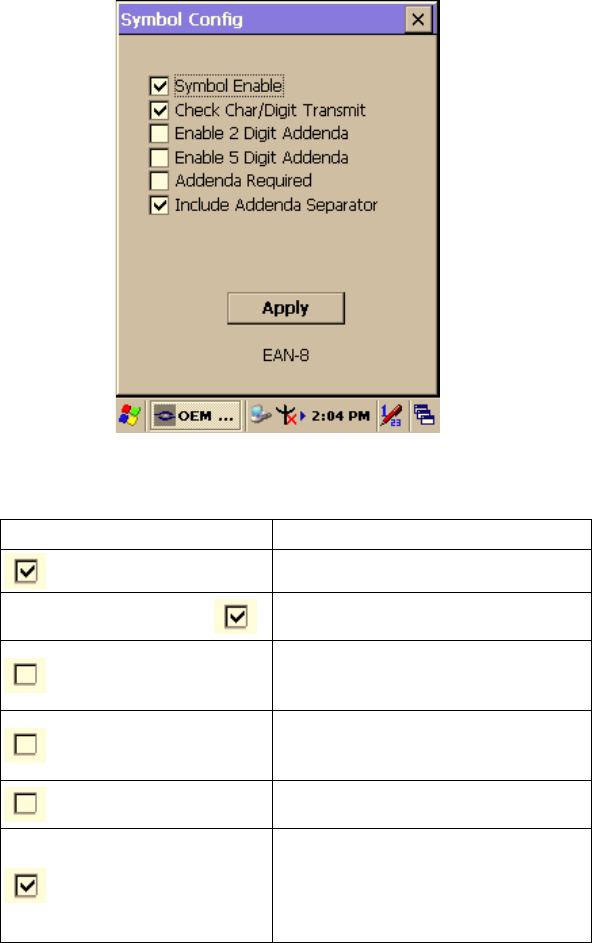
MARS-1030F User Manual 170
A.3.10 EAN-8
Functions:
Item Explanation
Symbol Enable Enable this barcode.
Check Char/Digit Transmit
Output the check digit at the end of the
scanned data.
Enable 2 Digit Addenda
Option allows decoding and outputting
of a 2 digit addendum at the end of all
scanned EAN-8 data.
Enable 5 Digit Addenda
Option allows decoding and outputting
of a 5 digits addendum at the end of all
scanned EAN-8 data.
Addenda Required Only reads EAN-8 barcodes that have
addenda.
Include Addenda Separator
When this feature is selected, the data
is output with a space between the
data from the main barcode and the
data from the addenda. When turned
off, there is no space.
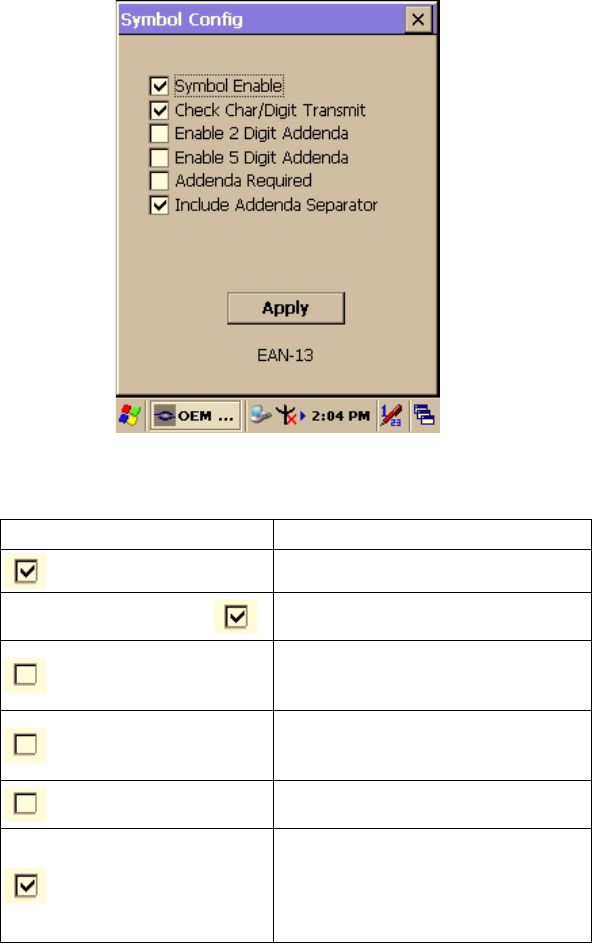
171 Appendix A
A.3.11 EAN-13
Functions:
Item Explanation
Symbol Enable Enable this barcode
Check Char/Digit Transmit The output of the check digit at the end
of the scanned data.
Enable 2 Digit Addenda
Option allows decoding and outputting
of a 2 digits addendum on the end of
all scanned EAN-13 data.
Enable 5 Digit Addenda
Option allows decoding and outputting
of a 5 digits addendum on the end of
all scanned EAN-13 data.
Addenda Required Only reads EAN-13 barcodes that
have addenda.
Include Addenda Separator
When this feature is selected, the data
is output with a space between the
data from the main barcode and the
data from the addenda. When turned
off, there is no space.
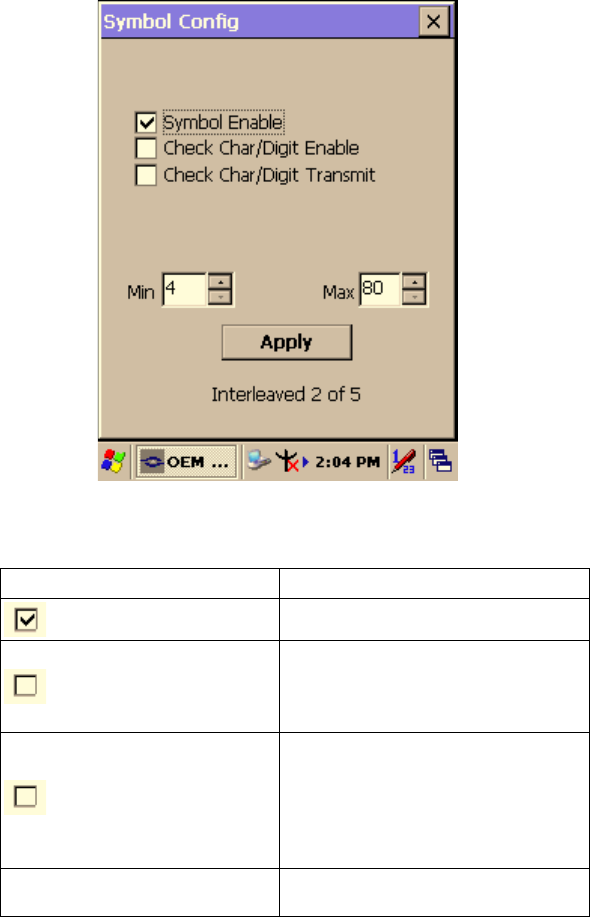
MARS-1030F User Manual 172
A.3.12 Interleaved 2 of 5
Functions:
Item Explanation
Symbol Enable Enable this barcode.
Check Char/Digit Enable
The scanner reads barcode data with
a check digit. If not checked, the
barcode will be read as though no
check digit was present.
Check Char/Digit Transmit
The scanner will only read Interleaved
2 of 5 barcodes printed with a check
digit, and will transmit this character at
the end of the scanned data. This
setting is only valid if check char/digit
is enabled.
Message Length The minimum and maximum length
ranges for the barcode are 2 - 80.
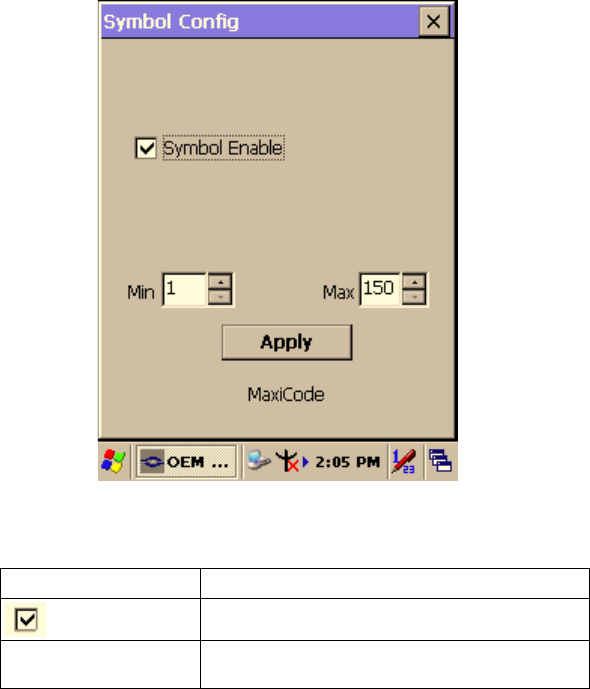
173 Appendix A
A.3.13 MaxiCode
Functions:
Item Explanation
Symbol Enable Enable this barcode
Message Length The minimum and maximum length ranges for
the barcode are 1 - 150.
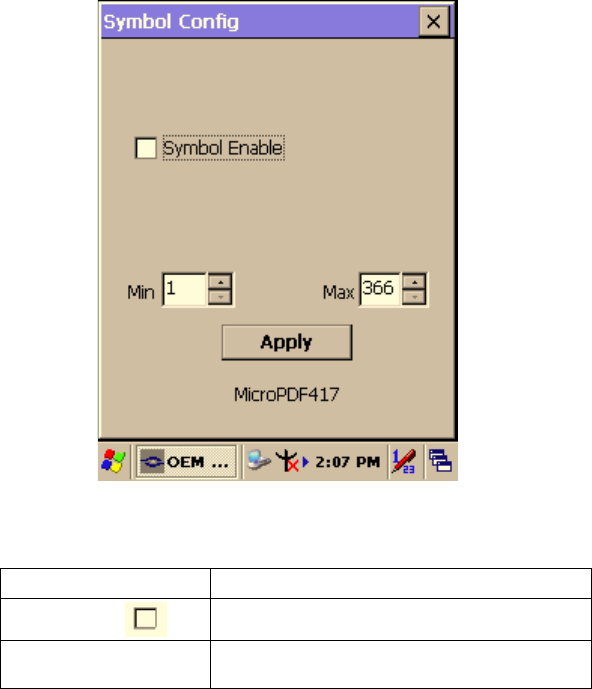
MARS-1030F User Manual 174
A.3.14 MicroPDF417
Functions:
Item Explanation
Symbol Enable Enable this barcode.
Message Length The minimum and maximum length ranges for
the barcode are 1 - 366.
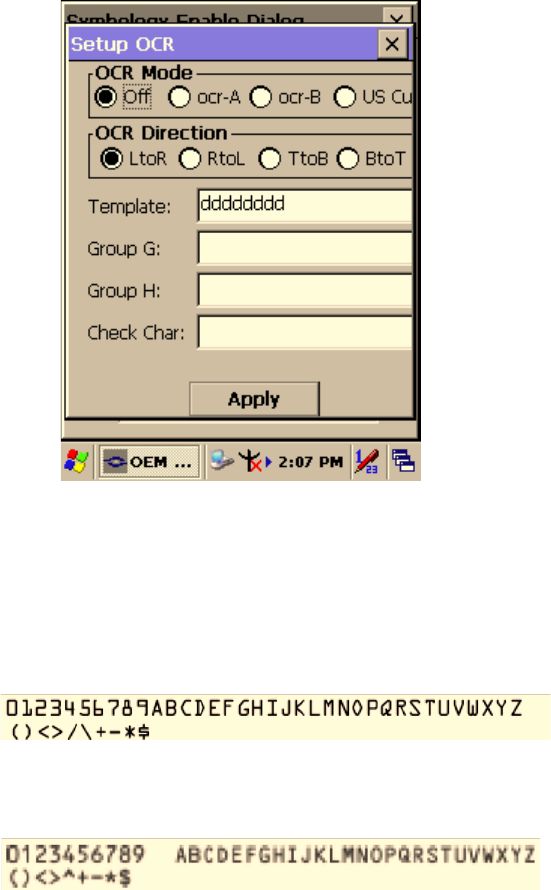
175 Appendix A
A.3.15 OCR-A, OCR-B, US Currency
The imager is able to read machine readable fonts used in optical charac-
ter recognition (OCR). The imager can read from 6 to 60 point OCR type-
face.
OCR Mode
•OCR-A
•OCR-B
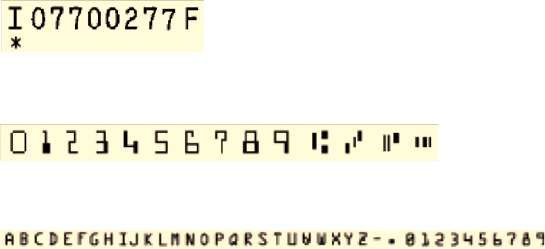
MARS-1030F User Manual 176
• U.S. Currency Serial Number (Money)
• MICR E-13B
•SEMI Font
Either select an OCR default, or create a custom template for the type of
OCR format intended to read. (See “OCR Templates” to create a custom
“template” or character string that defines the length and content of OCR
strings to be read with the imager.)
Note: Setting the template and check character options are essential for
OCR reading.
OCR Off turns off all OCR capability in the scanner, so the scanner will
be able to scan linear, stacked, matrix, and composite bar codes, but not
OCR fonts. In addition, any OCR templates previously created are erased.
The 8 digit default templates are reinstated for any future use of the OCR-
A, OCR-B, or U.S. Currency fonts.
If OCR-A, OCR-B, or U.S. Currency are selected, it is possible to scan
characters in that font. The default setting allows scanning of any 8 digit
combination. If creating an OCR template, character combinations that fit
the template can be scanned. (see Creating an OCR Template).
OCR Direction
The OCR Direction setting helps to prevent misreading of character
strings that could be interpreted differently in unique orientations if the
orientation of the characters being read is specific in relation to the posi-
tion of the imager; for example, “80086996” can read as “80086996” or
“96698008.” The default is Left-to-Right, (LtoR).
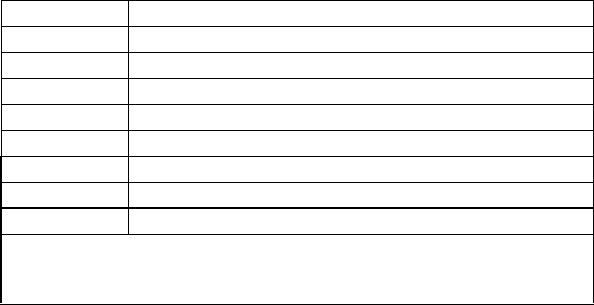
177 Appendix A
A.3.15.1 OCR Templates
A custom “template,” or character string defines the length and content of
OCR strings that will be read with the imager. Several choices are avail-
able when creating a custom template for the application. Create a tem-
plate for a single format, string together several formats, or you can create
a template for a user-defined variable. These choices are described in
more detail below.
A.3.15.2 Creating an OCR Template
A single template programs the imager to read any combination of char-
acters in the specified order. Refer to examples according to the Template
Characters table below.
Template Characters
Note: OCR templates default to eight digits, no check character.
a Represents any alphanumeric character (digit or letter)
c Represents a check character position
d Represents any digit
e Represents any available OCR character
g Represents character from user-defined variable “g”
h Represents character from user-defined variable “h”
l Represents any uppercase letter
t Marks the start of a new template
r Multi row indicator
All other characters represent themselves. Spaces can be used.
Note: In MICR E13 B templates, TOAD characters (capital letters T, O, A,
and D), represent Transit, On Us, Amount, and Dash.
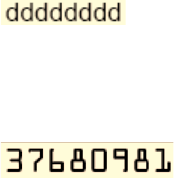
MARS-1030F User Manual 178
A.3.15.3 To Add an OCR Template
There are four main steps required for creating an OCR template. Below
them follows detailed descriptions and examples of specific situations
that require precise programming of the coding strings.
1. Turn on the OCR font to be read.
2. Begin building the template.
Scan the Enter OCR Template symbol.
3. Scan the characters for the string.
4. Exit OCR Template Editor
Scan Save OCR Template to save your entries. Discard OCR
Template exits without saving any OCR Template changes.
A.3.15.4 Scanning Characters
Use the Template Characters chart to determine what characters are
needed to create the required format. Use the OCR Programming Chart
(after the Sample Codes in the back of this manual) to scan the characters
for the template.
Example: It is required to read any combination of eight digits. The
template should be:
To create this template, first enable the OCR-A font. Scan the Enter
OCR Template symbol, and then scan the d from the OCR Programming
Chart in the back of this manual eight times. Scan Save OCR Template.
This would let you read any string of eight digits, for example:
A.3.15.5 Character Match Sequences
On the ASCII Conversion Chart (Code Page 1252), page A-4, find the
Hex value that represents the character(s) to match. Use the Programming
Chart (inside the back cover) to scan the numbers that represent these
characters.
Example: It is required to read three digits, three specific characters like
“ABC” and then three more digits.

179 Appendix A
The template would be:
To create this template, enable the OCR-A font. Scan the Enter OCR
Template symbol. Scan the d from the OCR Programming Chart three
times. Then scan 414243 from the inside back cover (the hex characters
for “A,” “B,” and “C”), and scan the d three more times. Scan Save OCR
Template.
This would read any string of three digits, then “ABC,” then any string of
three digits, for example:
A.3.15.6 Adding Spaces
You may also need to put spaces in your template.
Example: You need to read three digits, space, three specific characters,
like “ABC,” a space, and three more digits. The template would be:
To create this template, enable the OCR-A font. Scan the Enter OCR
Template symbol. Scan the d from the OCR Programming Chart three
times, and then scan 2041424320 from the Programming Chart (the hex
characters for “space,” “A,” “B,” “C,” “space”). Scan the d three more
times, and then scan Save OCR Template. This program will read any
string of three digits, space, “ABC,” space, and then any string of three
digits. For example:
Note: If using Quick * View to program, use the space bar to designate a
space and not the hex value of 20.
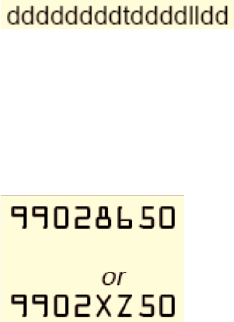
MARS-1030F User Manual 180
A.3.15.7 Stringing Together Multiple Formats (Creating
“Or” Statements)
To program the imager to accept and recognize many OCR formats, it is
necessary to string together each format beginning with a “t.” This unit
commands the imager to read optical characters that match any one of the
formats in the template.
Example: To read any combination of eight digits, or a combination of
four digits, two uppercase letters, and two digits.
The template would be:
To create this template, enable the OCR-A font. Scan the Enter OCR
Template symbol. Scan the d from the OCR Programming Chart eight
times, then scan the t to create the “or” statement. Then scan the charac-
ters for the second template. Scan d four times, scan l two times, then
scan d two more times. Scan Save OCR Template. This would let you
read either type of format, for example:
It is possible to string together as many templates as are required.
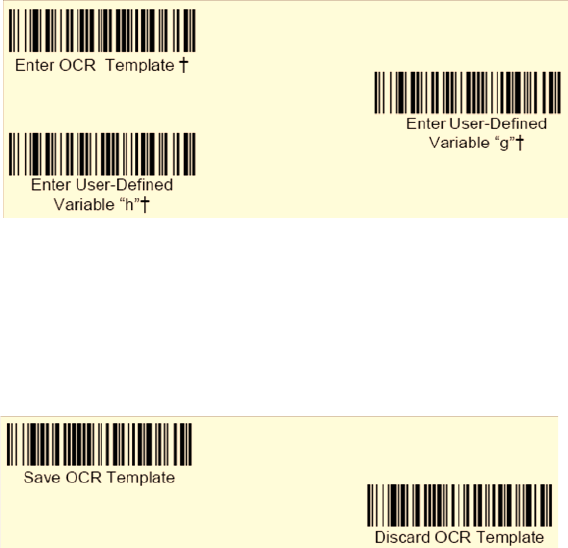
181 Appendix A
A.3.15.8 OCR Template Codes
Note: Reading more than three rows of OCR is not recommended.
Contact the factory if you have an application that requires reading four
or more rows of OCR.
† One or more two-digit numbers and Save are required after reading this
programming symbol. (Refer to the Programming Chart on the inside the
back cover of this manual.)
Exit Selections
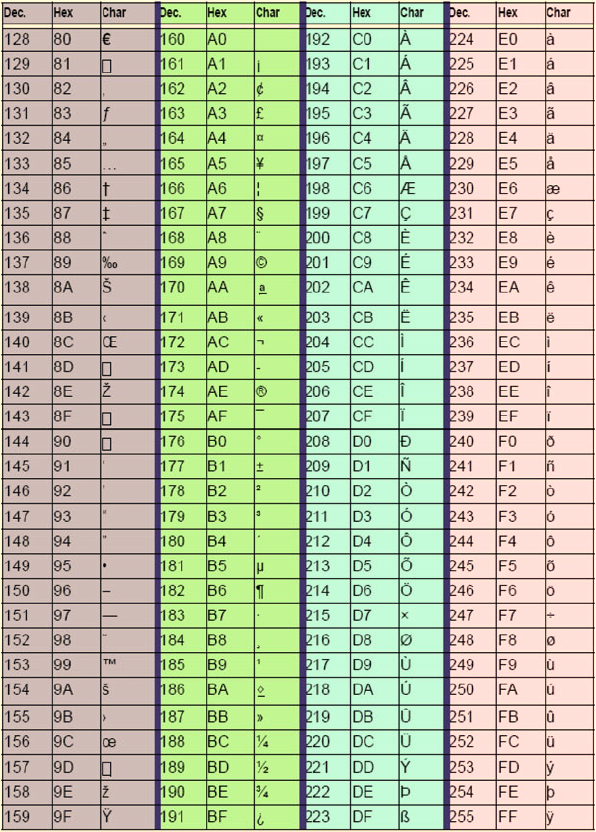
MARS-1030F User Manual 182
ASCII Conversion Chart (Code Page 1252)
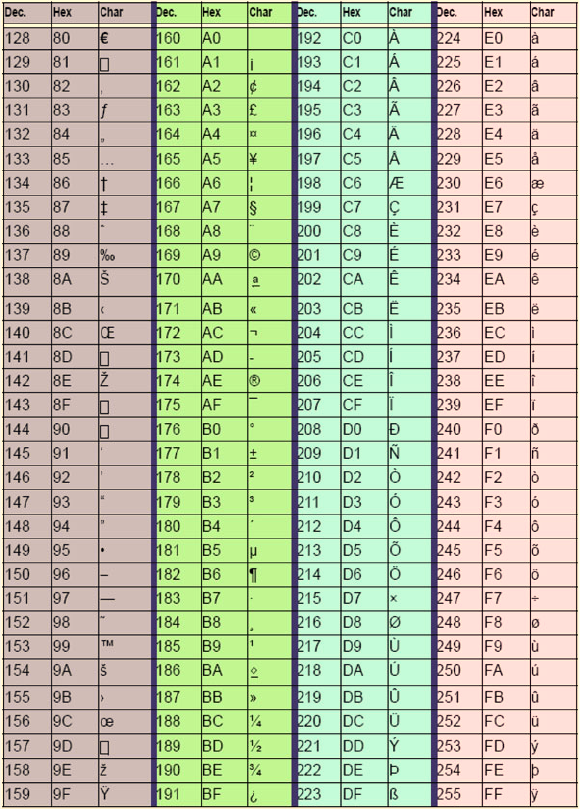
183 Appendix A
ASCII Conversion Chart (Code Page 1252)
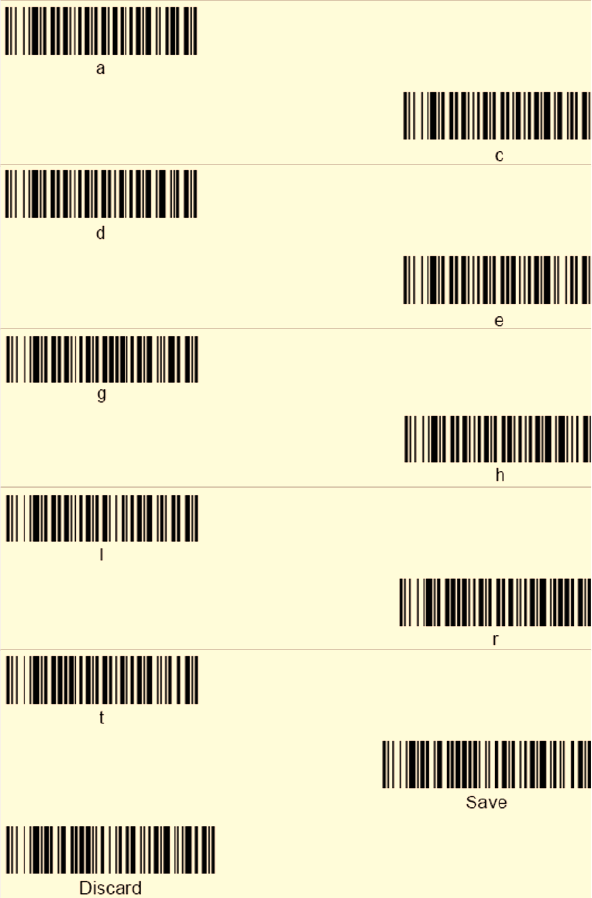
MARS-1030F User Manual 184
OCR Programming Chart
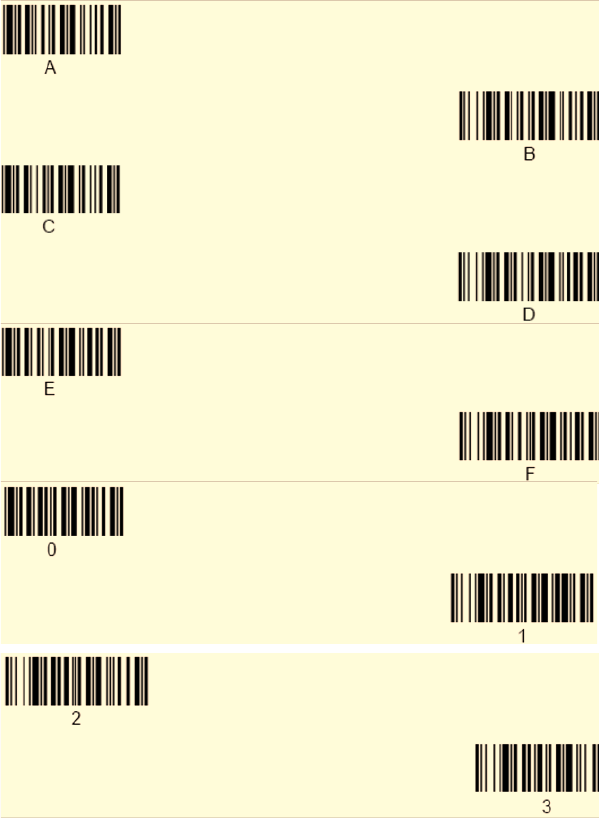
185 Appendix A
Programming Chart
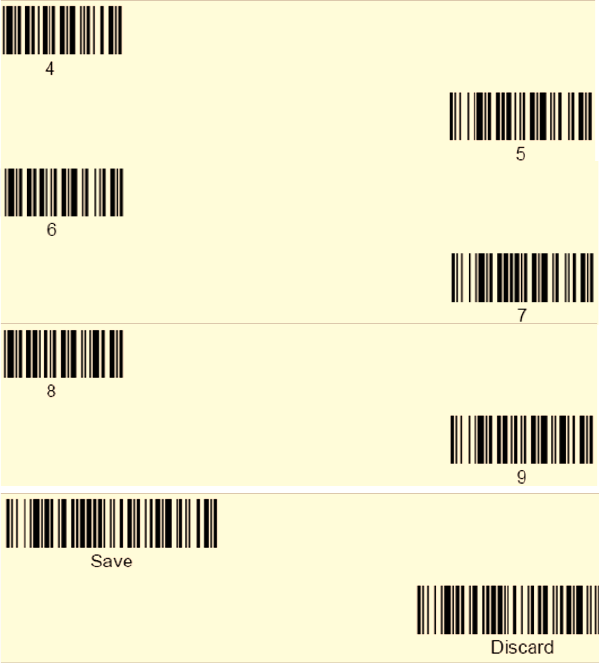
MARS-1030F User Manual 186
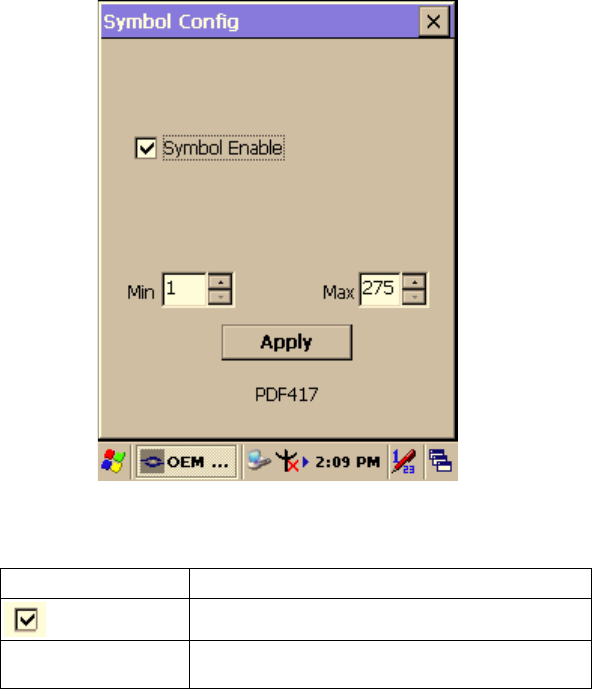
187 Appendix A
A.3.16 PDF417
Functions:
Item Explanation
Symbol Enable Enable this barcode.
Message Length The minimum and maximum length ranges for the
barcode are 1 - 2750.
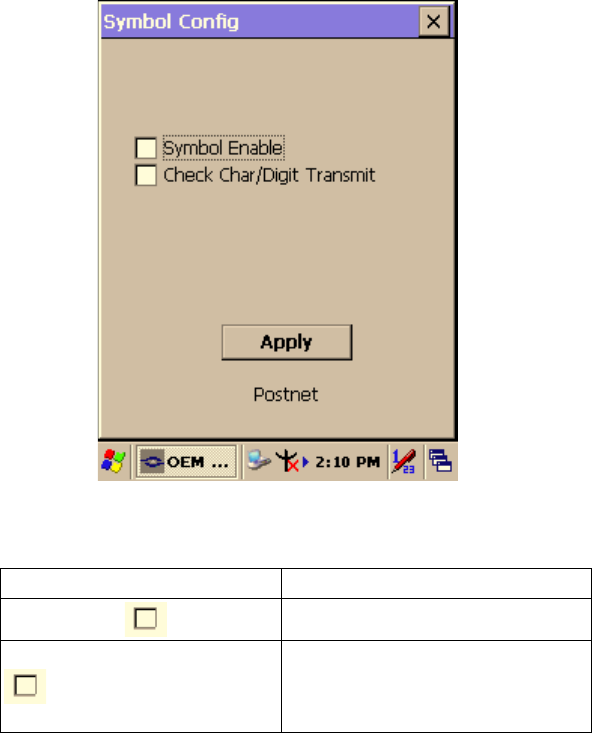
MARS-1030F User Manual 188
A.3.17 Postnet
Functions:
Item Explanation
Symbol Enable Enable this barcode.
Check Char/Digit Transmit
The scanner can only read US Post-
net bar codes printed with a check
character, and will transmit this char-
acter at the end of the scanned data.
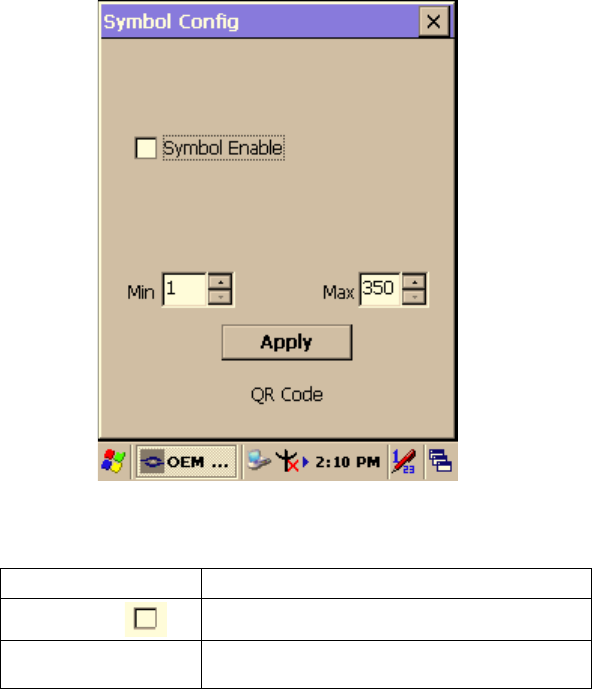
189 Appendix A
A.3.18 QR Code
Functions:
Item Explanation
Symbol Enable Enable this barcode.
Message Length The minimum and maximum length ranges for
the barcode are 1 - 3500.
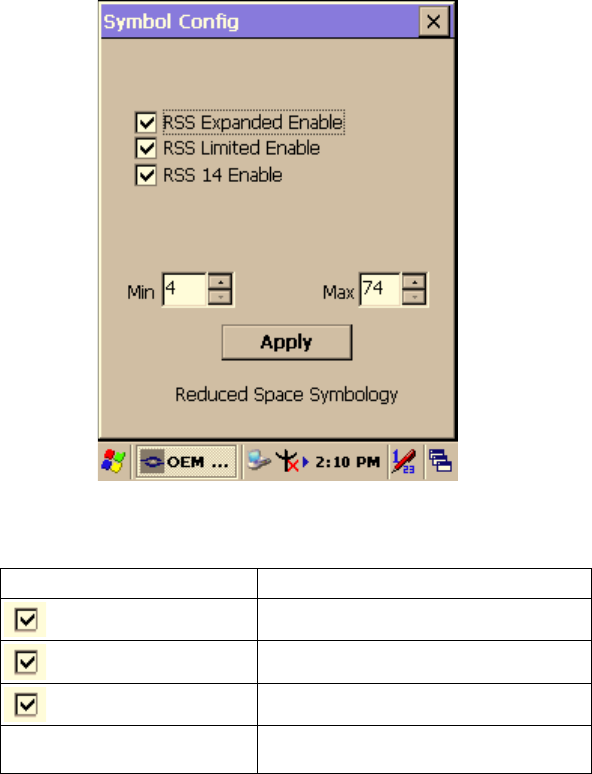
MARS-1030F User Manual 190
A.3.19 Reduced Space Symbology
Functions:
Item Explanation
RSS Expanded Enable Enable RSS Expanded code.
RSS Limited Enable Enable RSS Limited code.
RSS 14 Enable Enable RSS 14 code.
Message Length The minimum and maximum length
ranges for the barcode are 4 - 74.
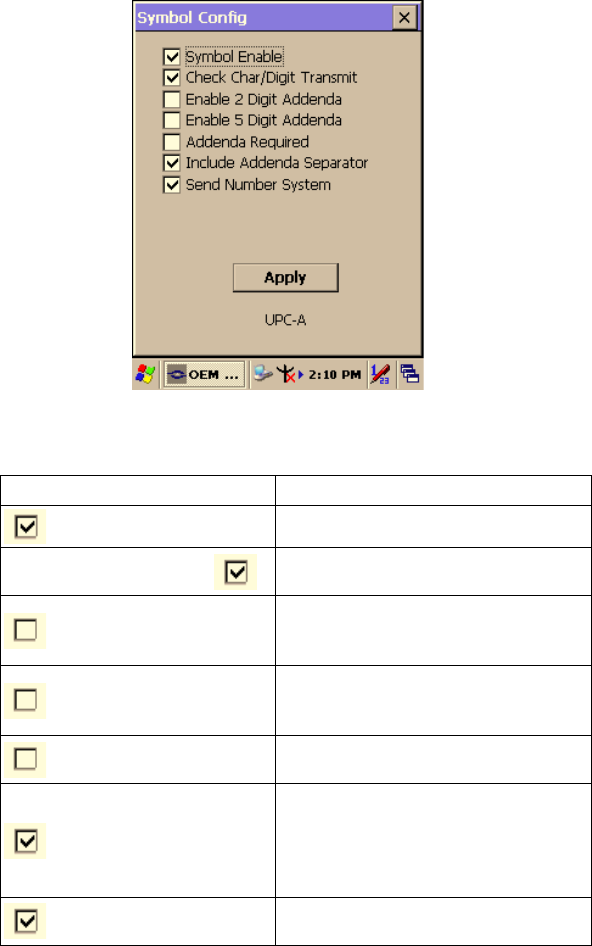
191 Appendix A
A.3.20 UPC-A
Functions:
Item Explanation
Symbol Enable Enable this barcode.
Check Char/Digit Transmit The output of the check digit at the end
of the scanned data.
Enable 2 Digit Addenda
Option allows decoding and outputting
of a 2 digit addendum at the end of all
scanned UPC-A data.
Enable 5 Digit Addenda
Option allows decoding and outputting
of a 5 digit addendum at the end of all
scanned UPC-A data.
Addenda Required Only reads UPC-A barcodes that have
addenda.
Include Addenda Separator
When this feature is selected, the data
is output with a space between the
data from the main barcode and the
data from the addenda. When turned
off, there is no space.
Send Number System
Transmits the numeric system digit of
a UPC symbol.
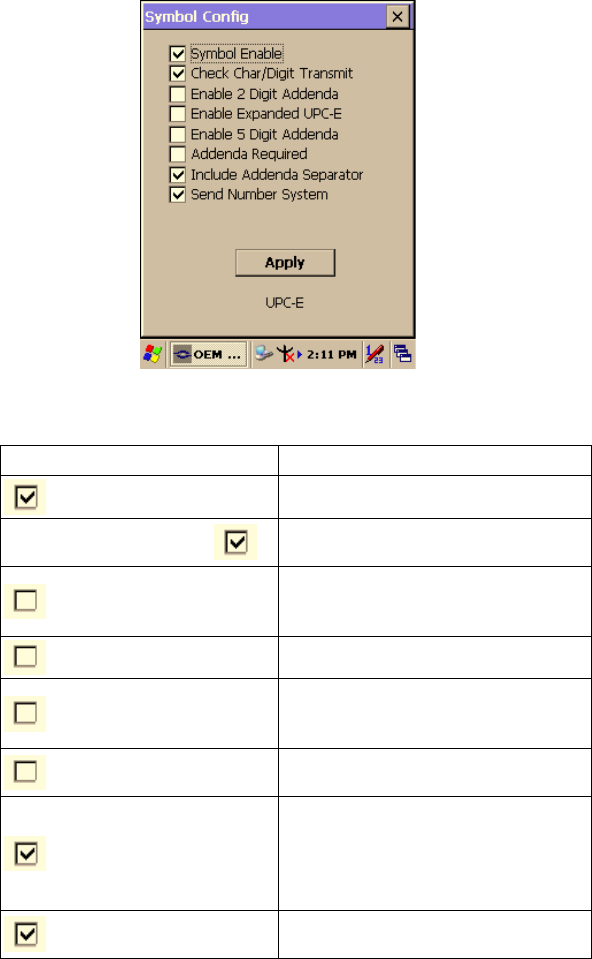
MARS-1030F User Manual 192
A.3.21 UPC-E
Functions:
Item Explanation
Symbol Enable Enable this barcode.
Check Char/Digit Transmit The output of the check digit at the
end of the scanned data.
Enable 2 Digit Addenda
Option allows decoding and outputting
of a 2 digit addendum at the end of all
scanned UPC-E data.
Enable Expanded UPC-E Enable UPC-E Expanded code.
Enable 5 Digit Addenda
Option allows decoding and outputting
of a 5 digit addendum at the end of all
scanned UPC-E data.
Addenda Required
Only reads UPC-E barcodes that have
addenda.
Include Addenda Separator
When this feature is selected, the data
is output with a space between the
data from the main barcode and the
data from the addenda. When turned
off, there is no space.
Send Number System
Transmits the numeric system digit of
a UPC-E symbol.
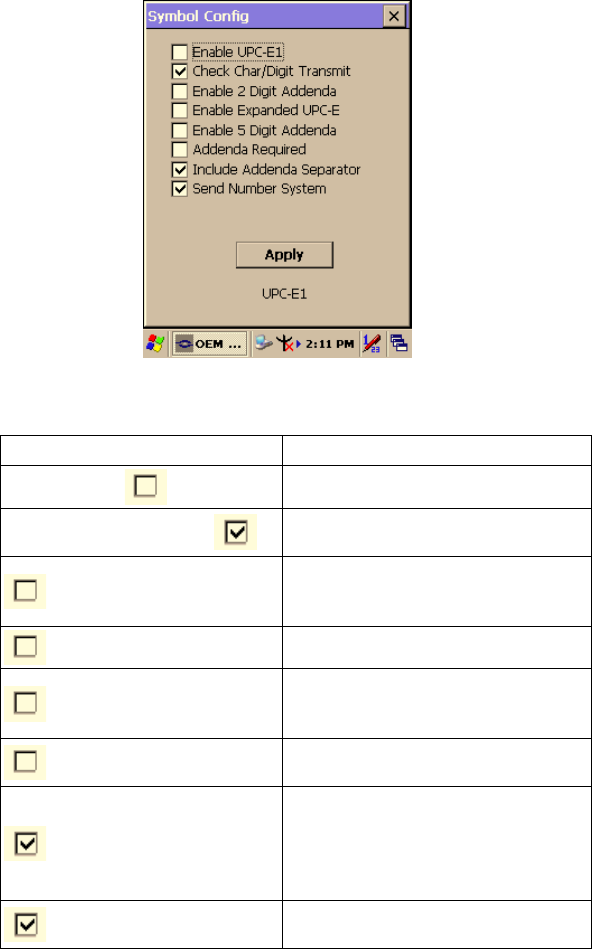
193 Appendix A
A.3.22 UPC-E1
Functions:
Item Explanation
Symbol Enable Enable this barcode.
Check Char/Digit Transmit The output of the check digit at the
end of the scanned data.
Enable 2 Digit Addenda
Option allows decoding and output-
ting of a 2 digit addendum at the end
of all scanned UPC-E1 data.
Enable Expanded UPC-E Enable UPC-E Expanded code.
Enable 5 Digit Addenda
Option allows decoding and output-
ting of a 5 digit addendum at the end
of all scanned UPC-E1 data.
Addenda Required Only reads UPC-E1 barcodes that
have addenda.
Include Addenda Separator
When this feature is selected, the
data is output with a space between
the data from the main barcode and
the data from the addenda. When
turned off, there is no space.
Send Number System
Transmits the numeric system digit of
a UPC-E1 symbol.
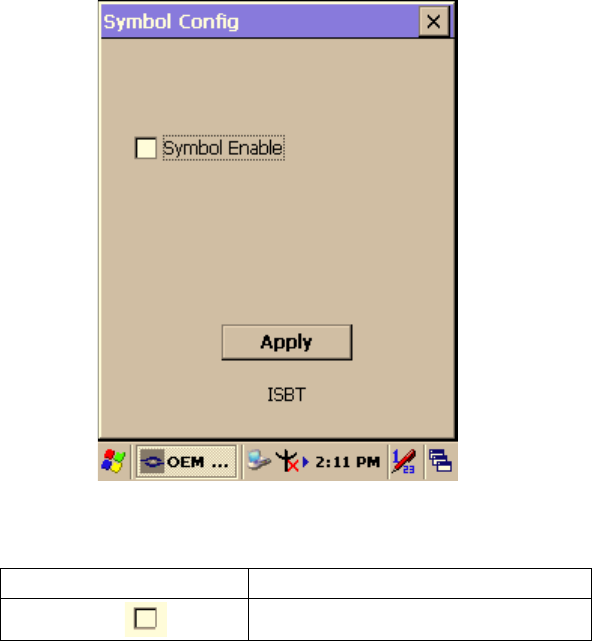
MARS-1030F User Manual 194
A.3.23 ISBT
Functions:
Item Explanation
Symbol Enable Enable this barcode.
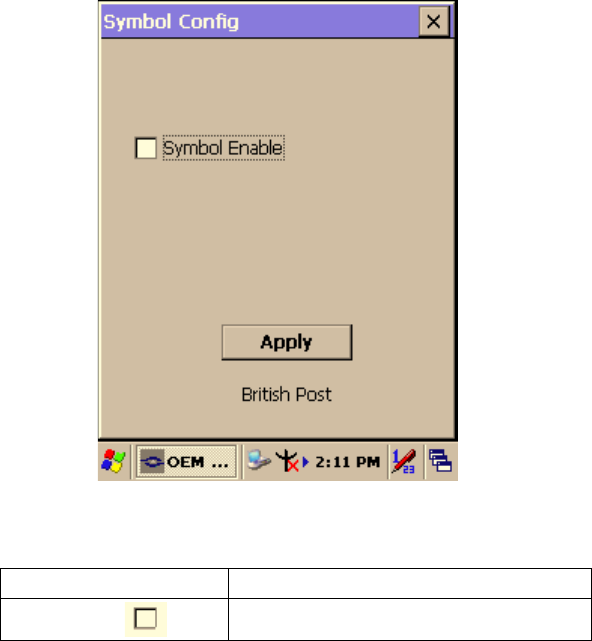
195 Appendix A
A.3.24 British Post
Functions:
Item Explanation
Symbol Enable Enable this barcode.
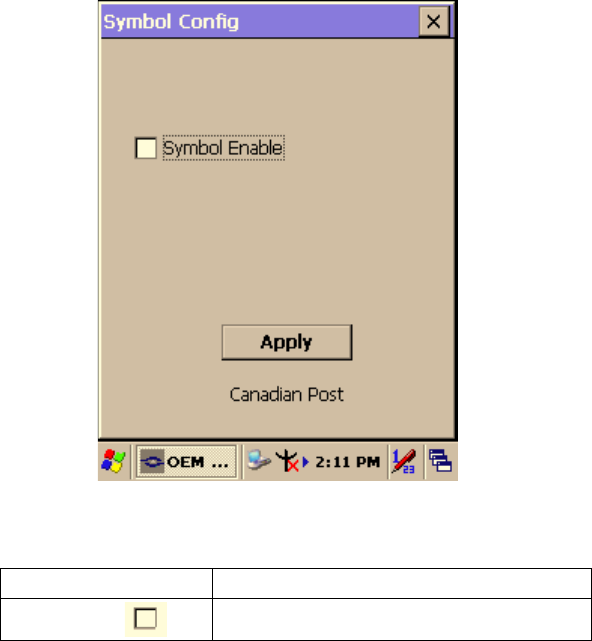
MARS-1030F User Manual 196
A.3.25 Canadian Post
Functions:
Item Explanation
Symbol Enable Enable this barcode.
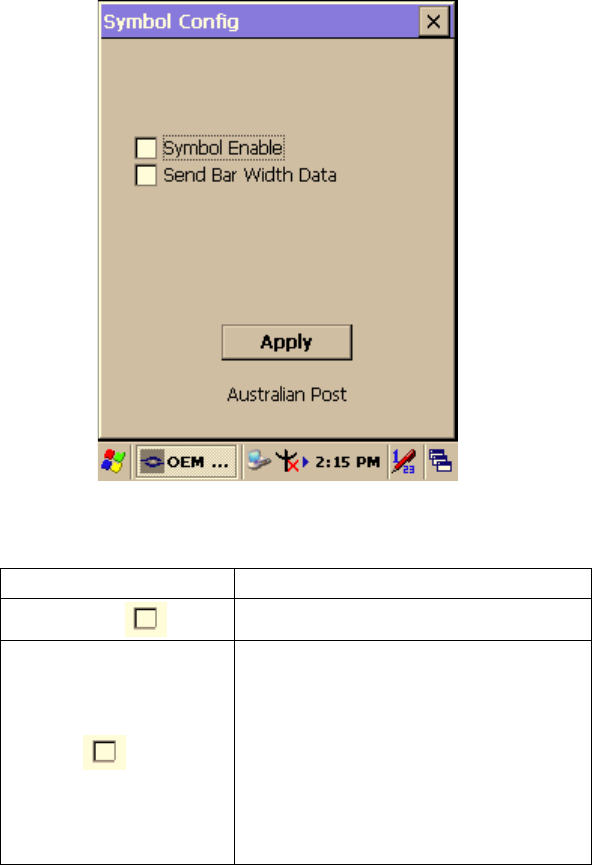
197 Appendix A
A.3.26 Australian Post
Functions:
Item Explanation
Symbol Enable Enable this barcode.
Send Bar Width Data
Australian Post is a 4-state symbology that
was designed with a non-defined user area.
The user can define how that area field is
interpreted. Most systems have dedicated
decoders that will not decode a symbology
that is not already defined. If you select
Send Bar Width Data, the bar levels will be
outputted (0 - 3 for the four states) so that
the receiving device can decode appropri-
ately.
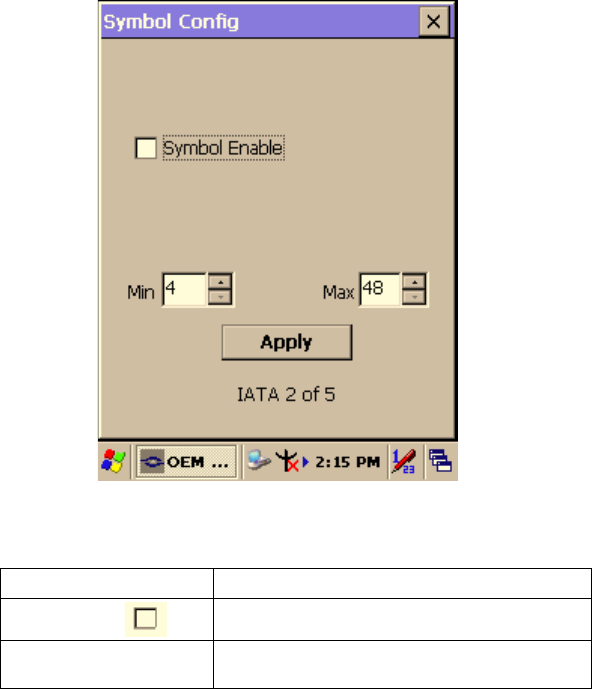
MARS-1030F User Manual 198
A.3.27 IATA 2 of 5
Functions:
Item Explanation
Symbol Enable Enable this barcode.
Message Length The minimum and maximum length ranges for
the barcode are 1 - 48.
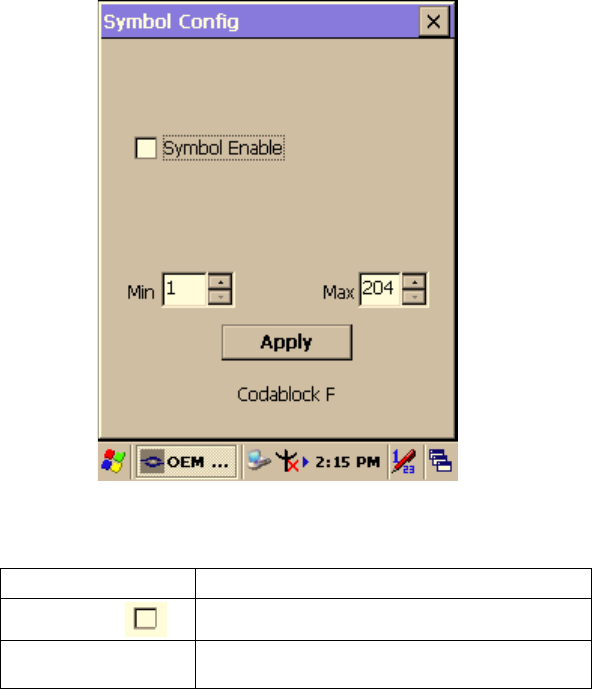
199 Appendix A
A.3.28 Codablock F
Functions:
Item Explanation
Symbol Enable Enable this barcode.
Message Length The minimum and maximum length ranges for
the barcode are 1 - 2048.
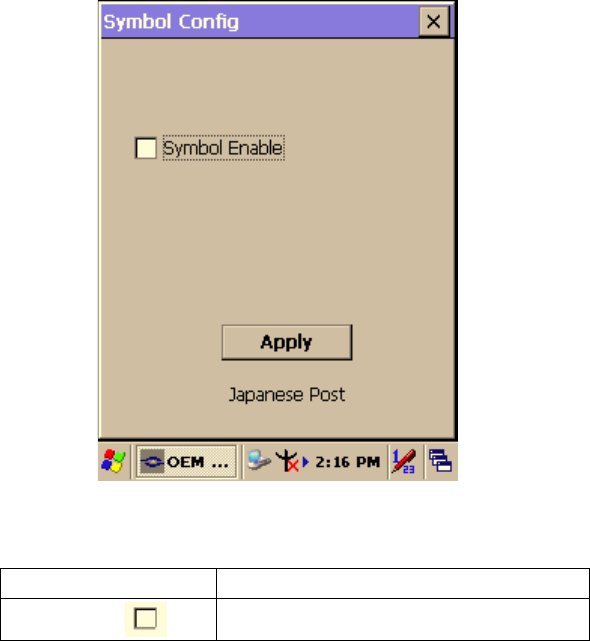
MARS-1030F User Manual 200
A.3.29 Japanese Post
Functions:
Item Explanation
Symbol Enable Enable this barcode.
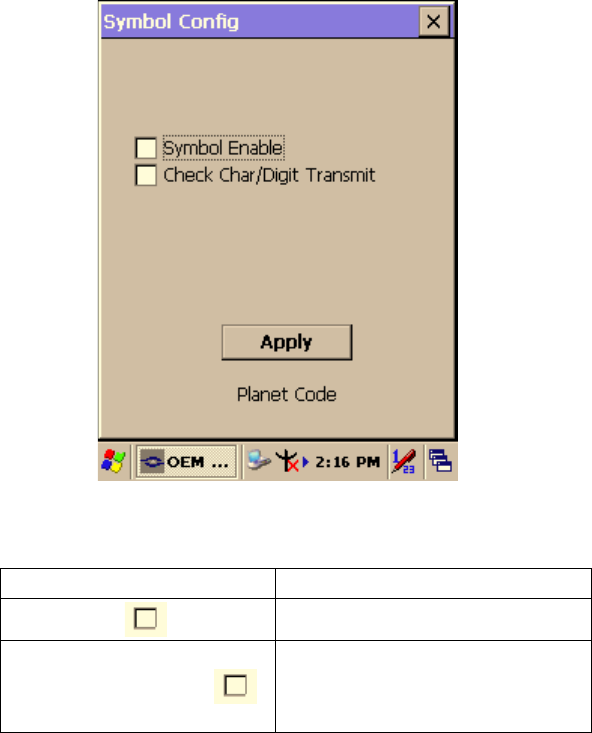
201 Appendix A
A.3.30 Planet Code
Functions:
Item Explanation
Symbol Enable Enable this barcode.
Check Char/Digit Transmit
The scanner only reads Planet bar-
codes printed with a check character,
and transmits this character at the end
of the scanned data.
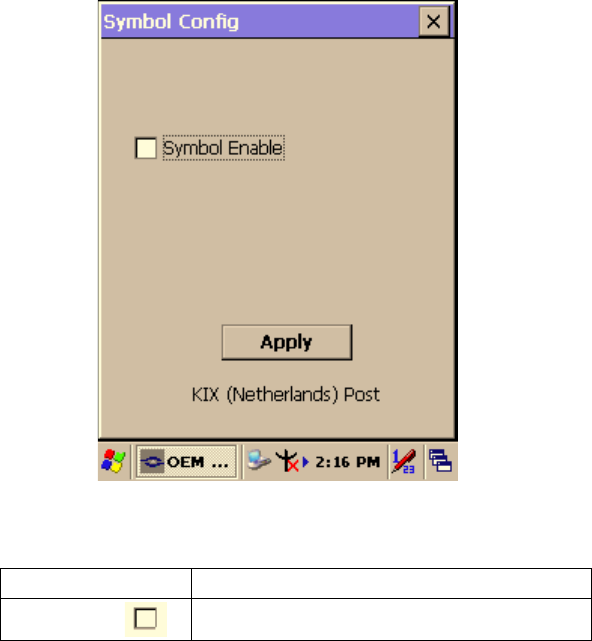
MARS-1030F User Manual 202
A.3.31 KIX (Netherlands) Post
Functions:
Item Explanation
Symbol Enable Enable this barcode.
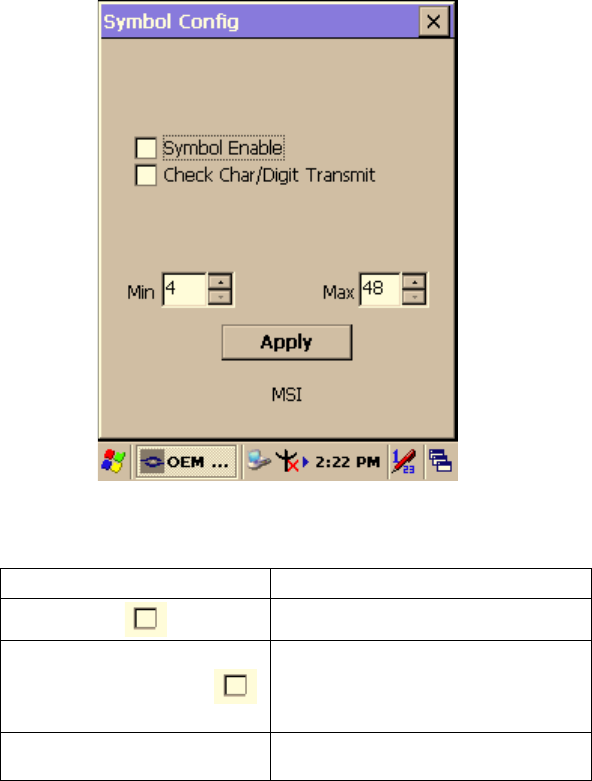
203 Appendix A
A.3.32 MSI
Functions:
Item Explanation
Symbol Enable Enable this barcode.
Check Char/Digit Transmit
The scanner only reads MSI barcodes
printed with a check character, and
transmits this character at the end of
the scanned data.
Message Length The minimum and maximum length
ranges for the barcode are 4 - 48.
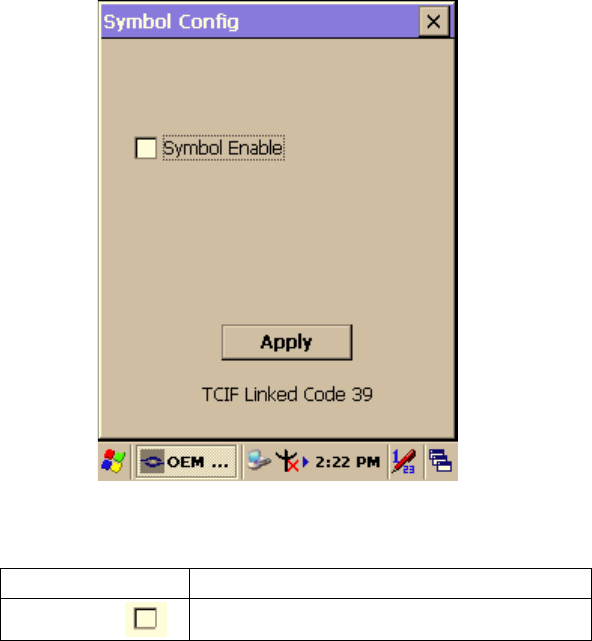
MARS-1030F User Manual 204
A.3.33 TCIF Linked Code 39
Functions:
Item Explanation
Symbol Enable Enable this barcode.
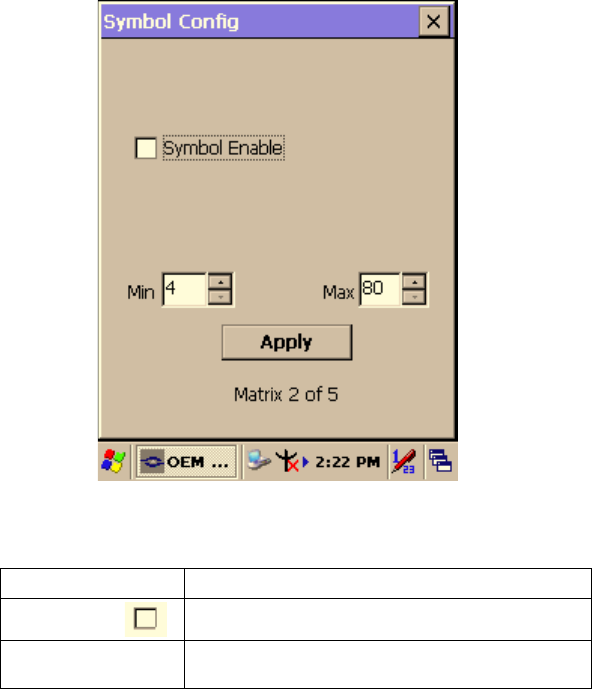
205 Appendix A
A.3.34 Matrix 2 of 5
Functions:
Item Explanation
Symbol Enable Enable this barcode.
Message Length The minimum and maximum length ranges for the
barcode are 1 - 80.
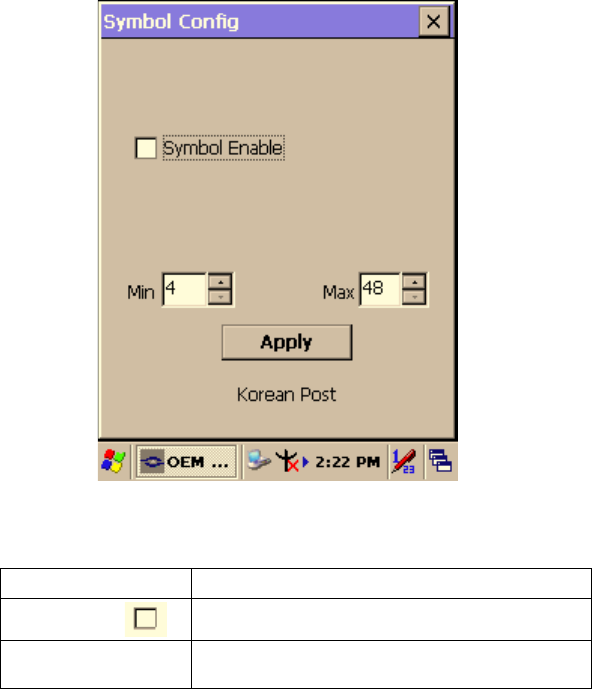
MARS-1030F User Manual 206
A.3.35 Korean Post
Functions:
Item Explanation
Symbol Enable Enable this barcode.
Message Length The minimum and maximum length ranges for
the barcode are 2 - 80.